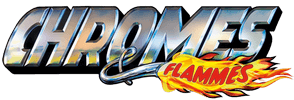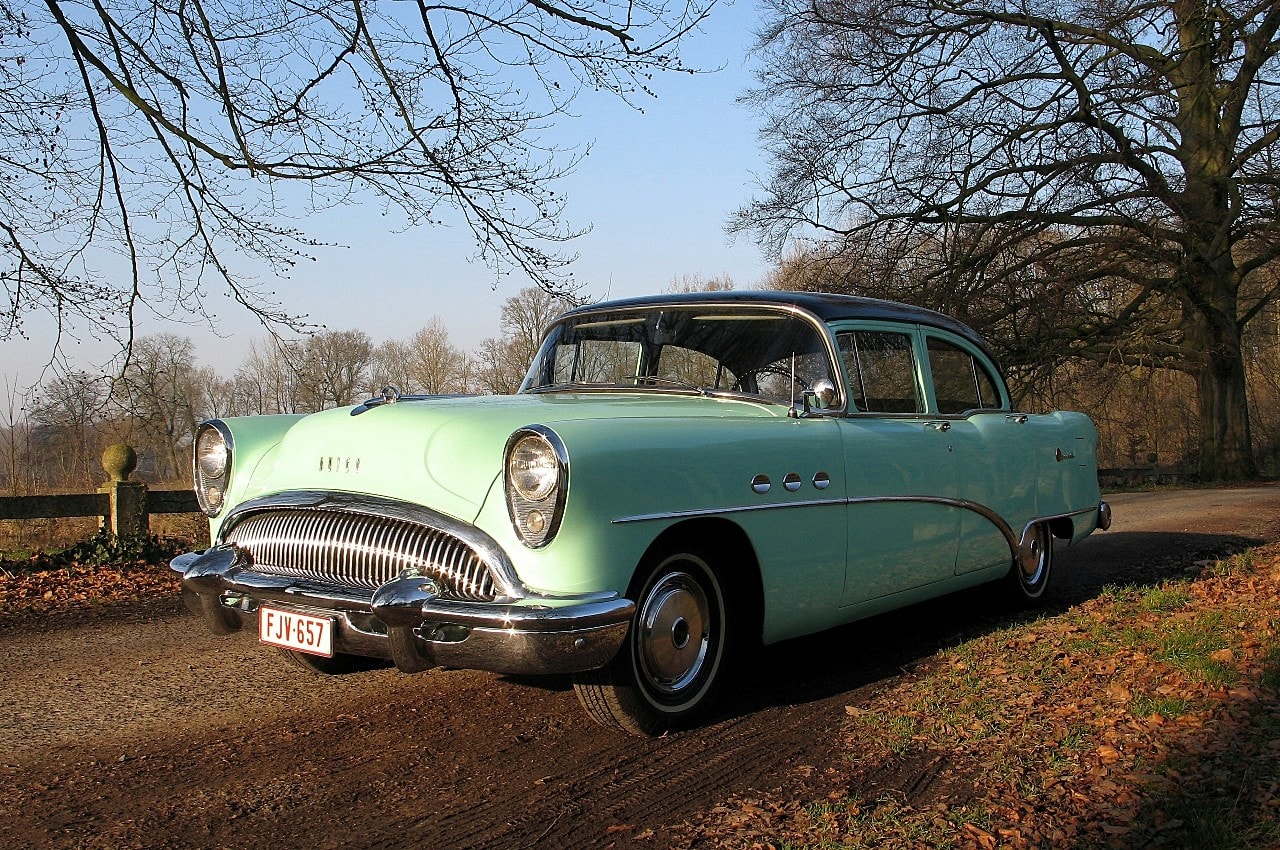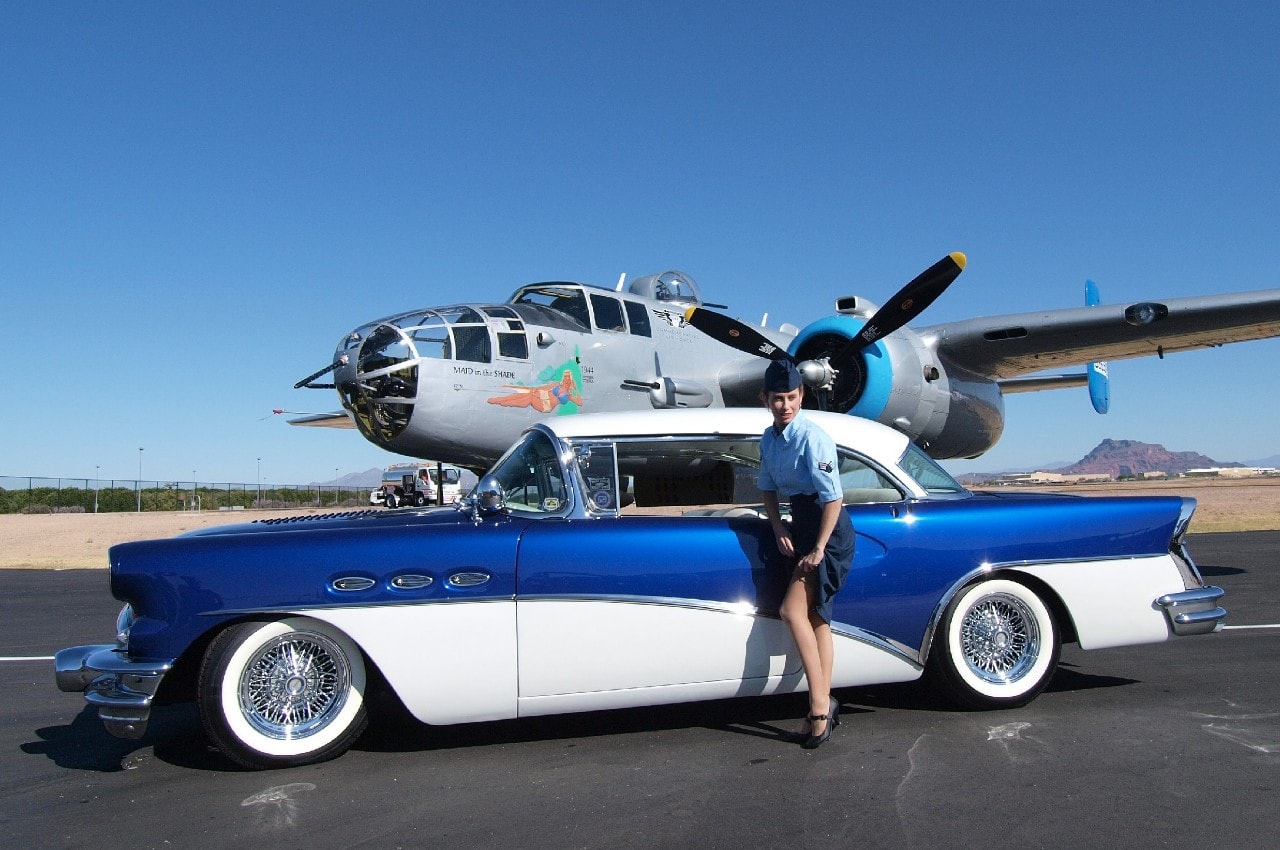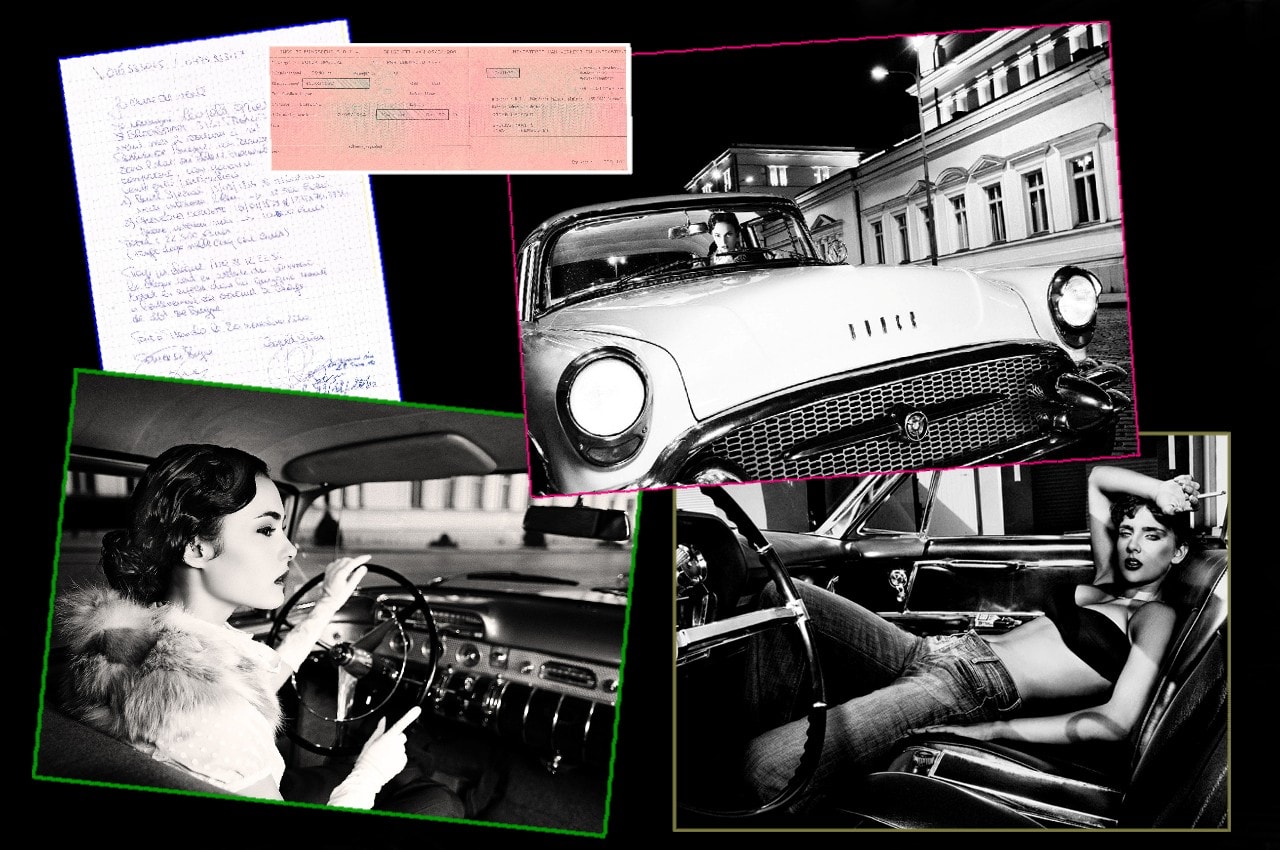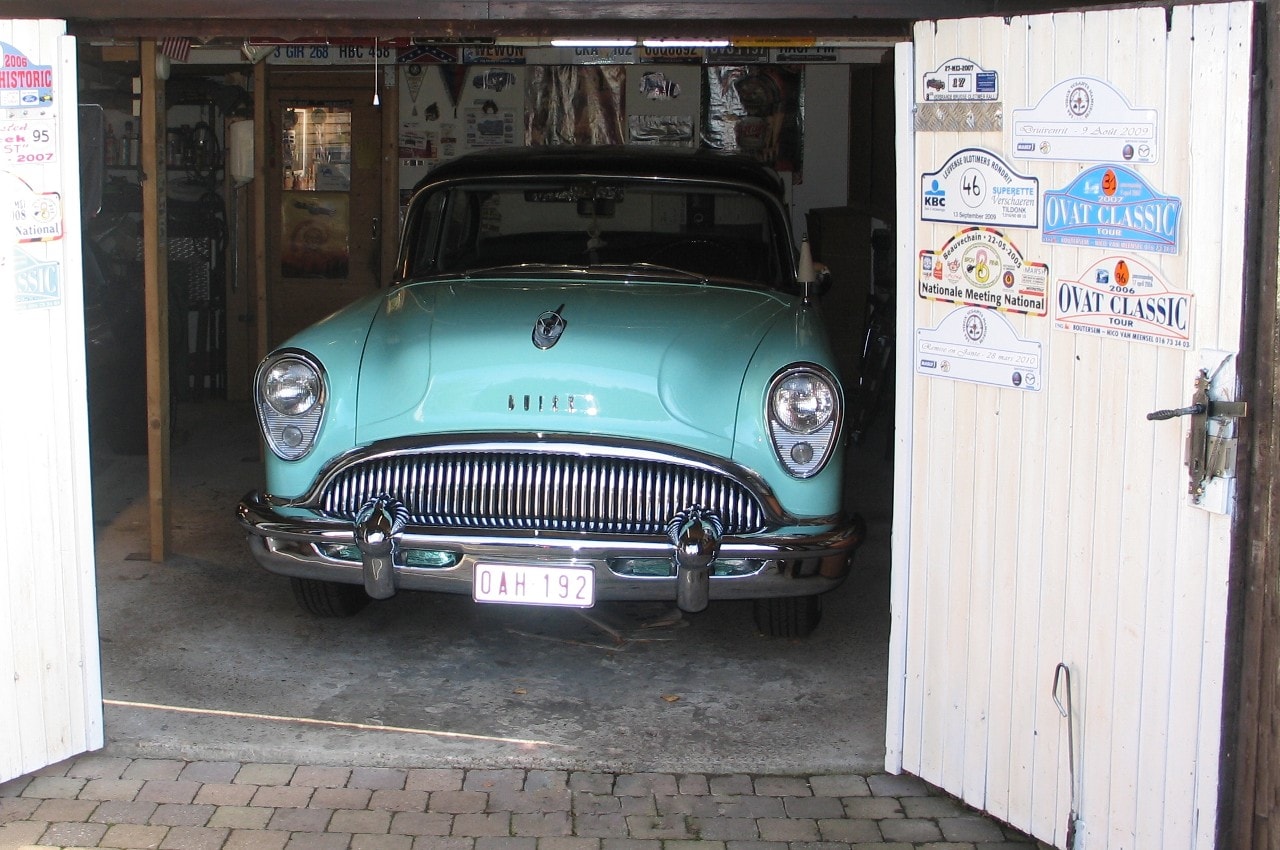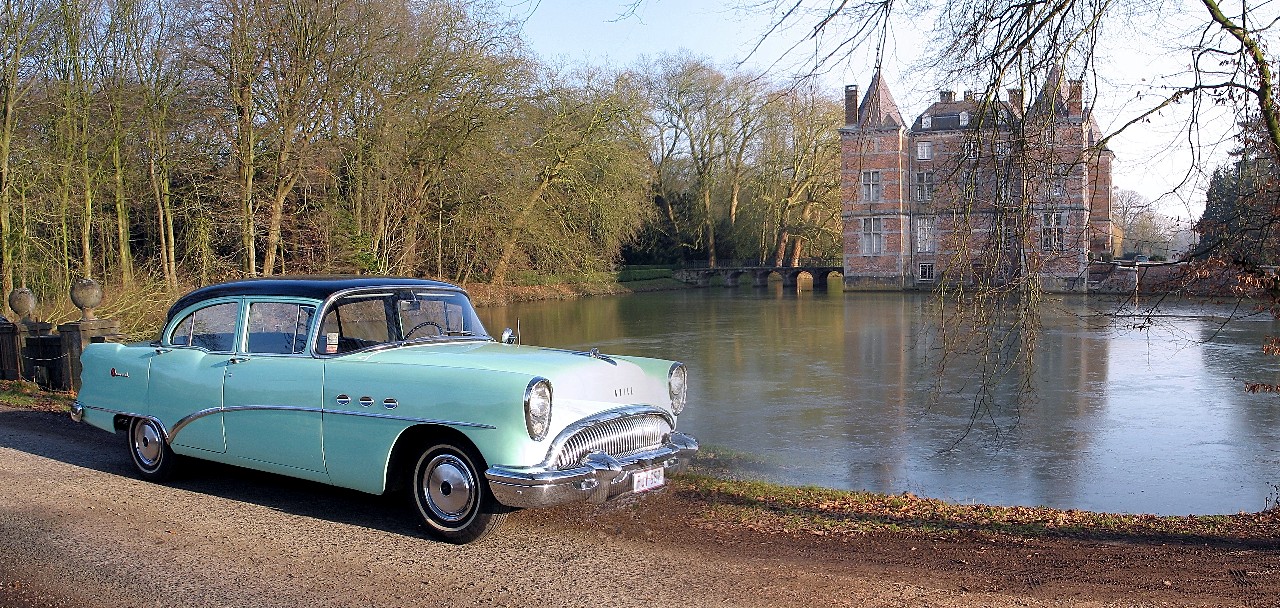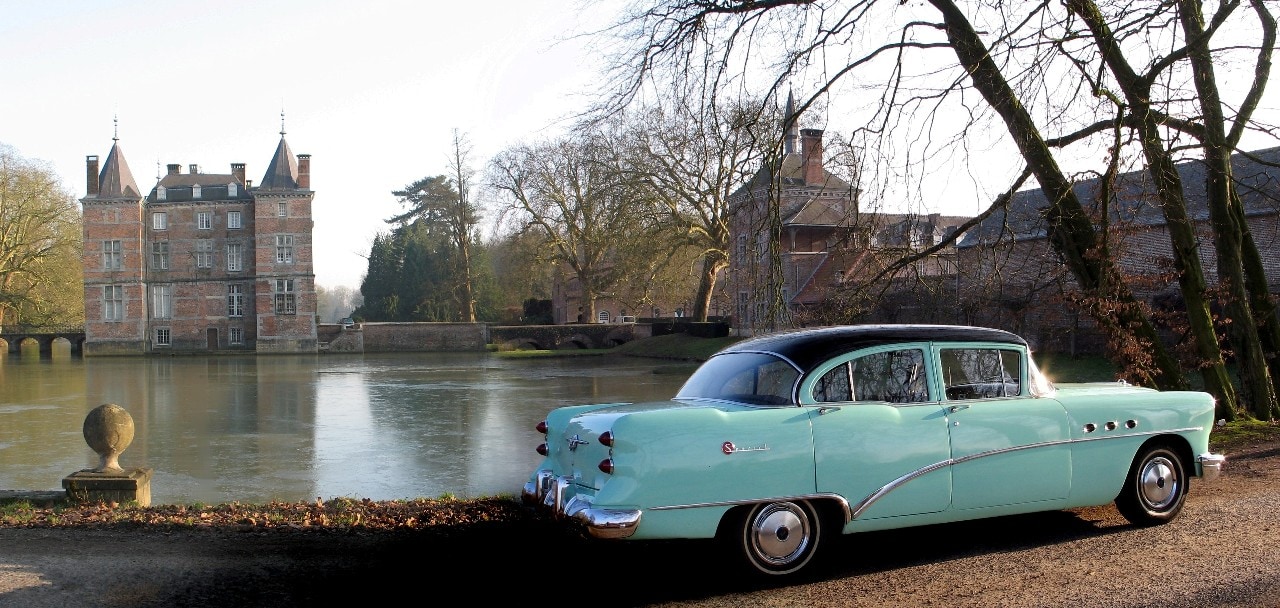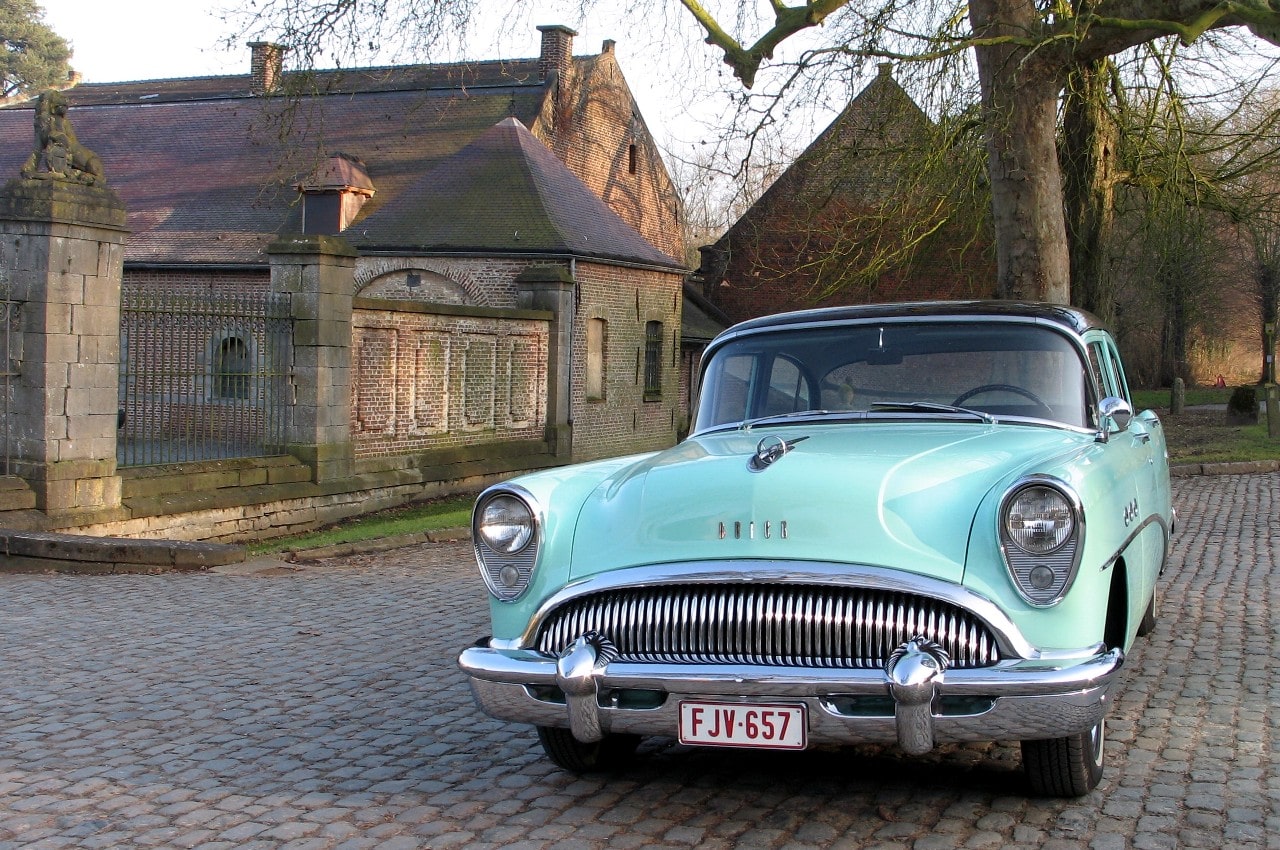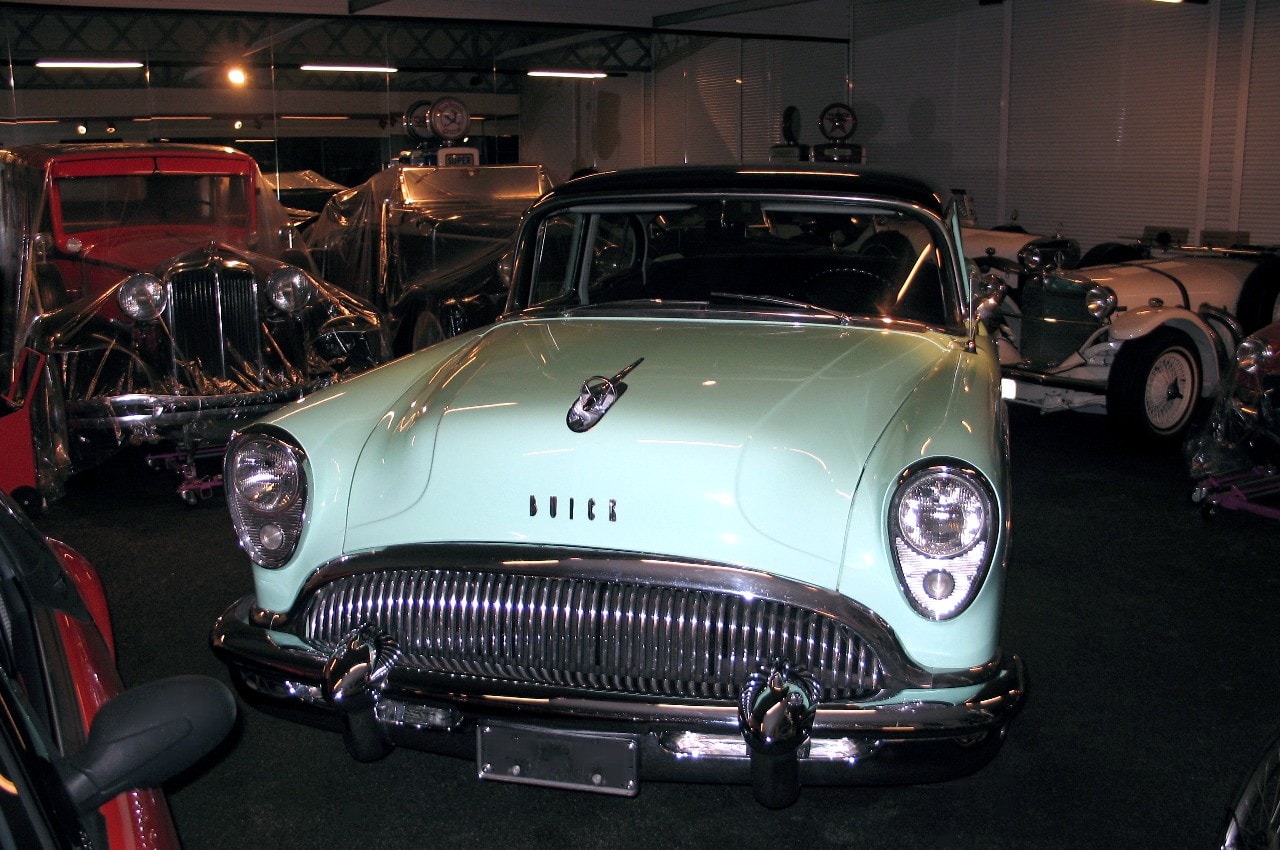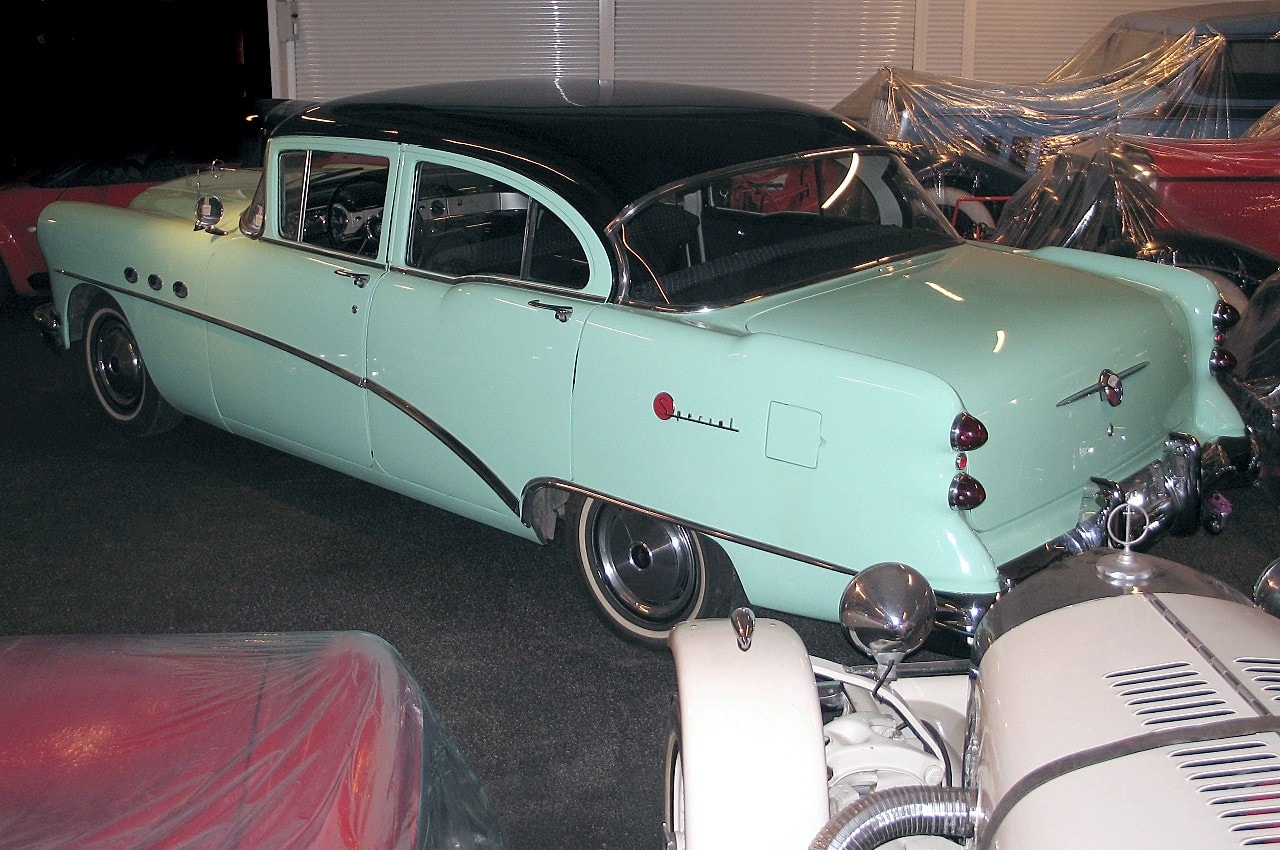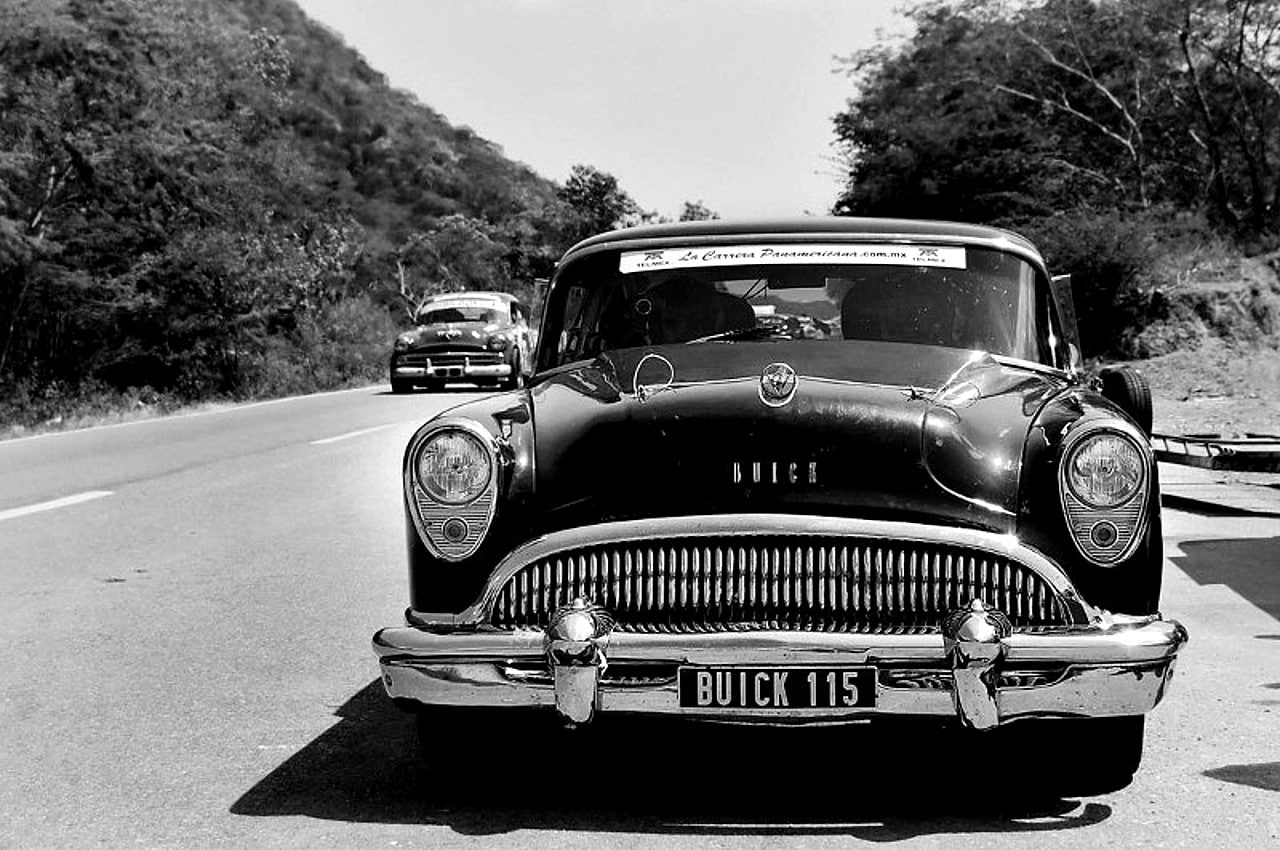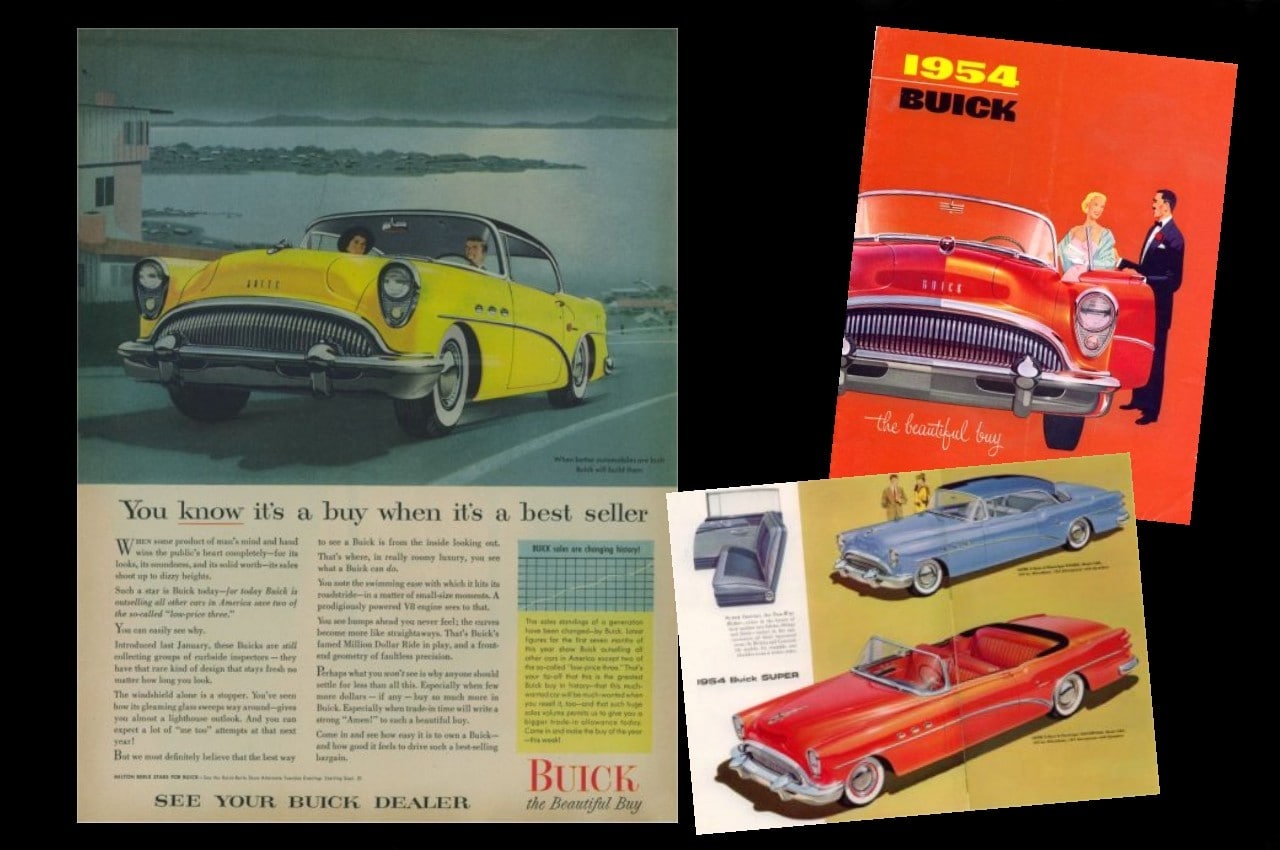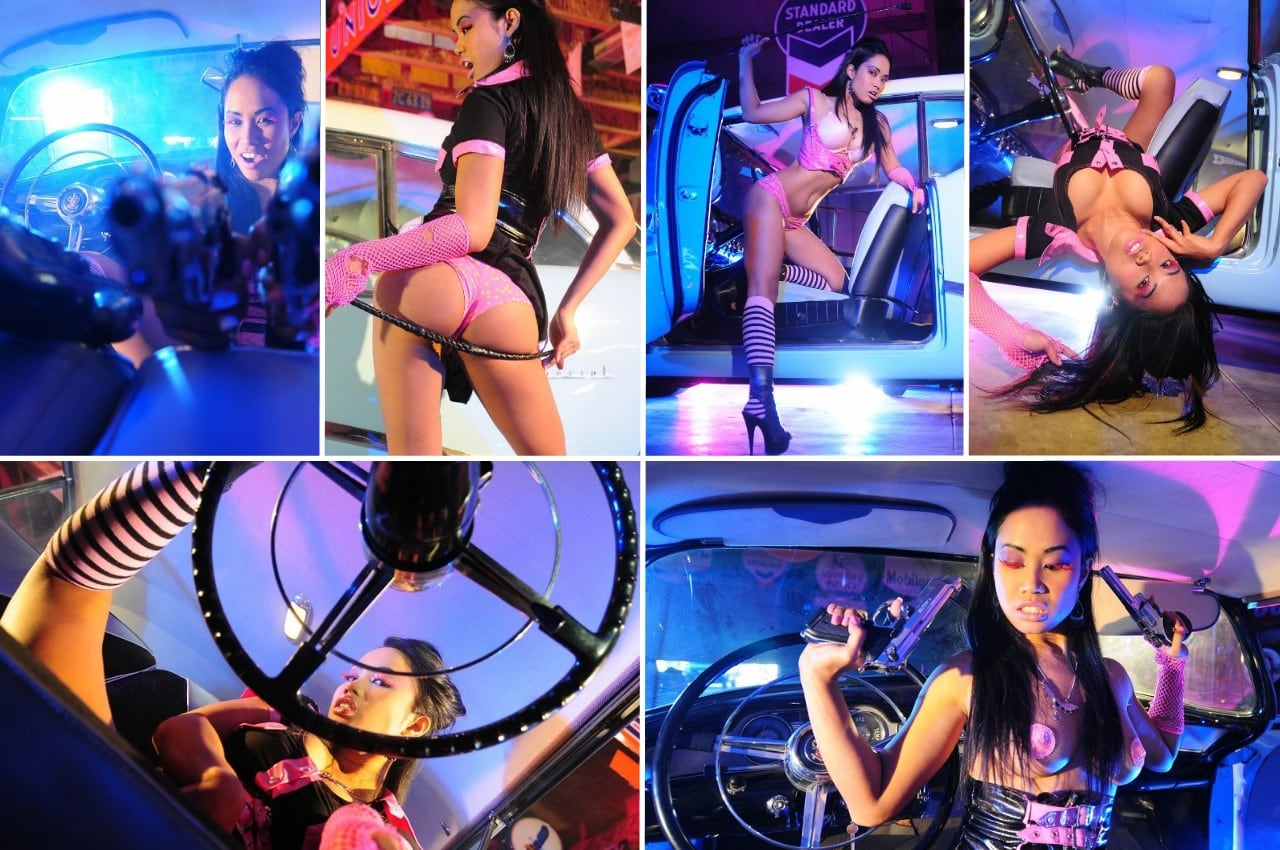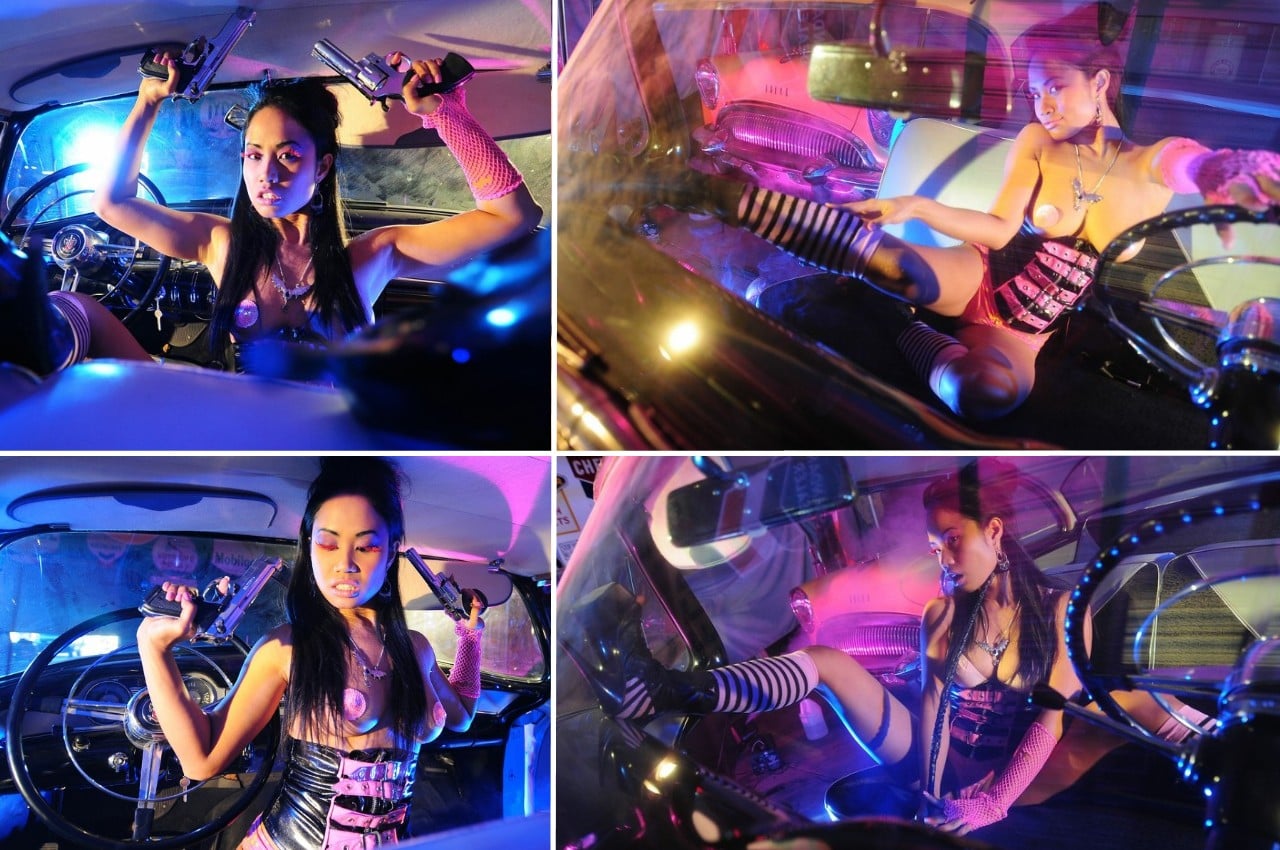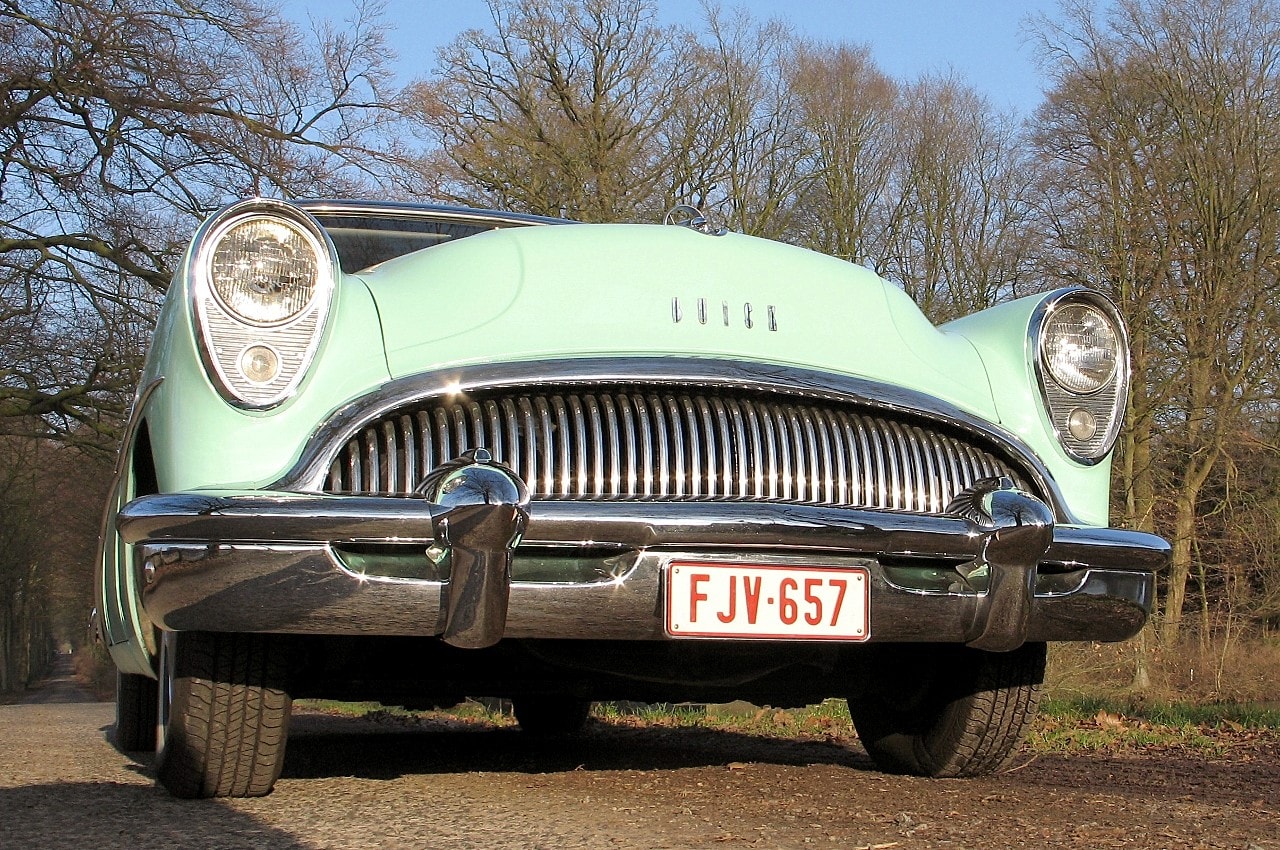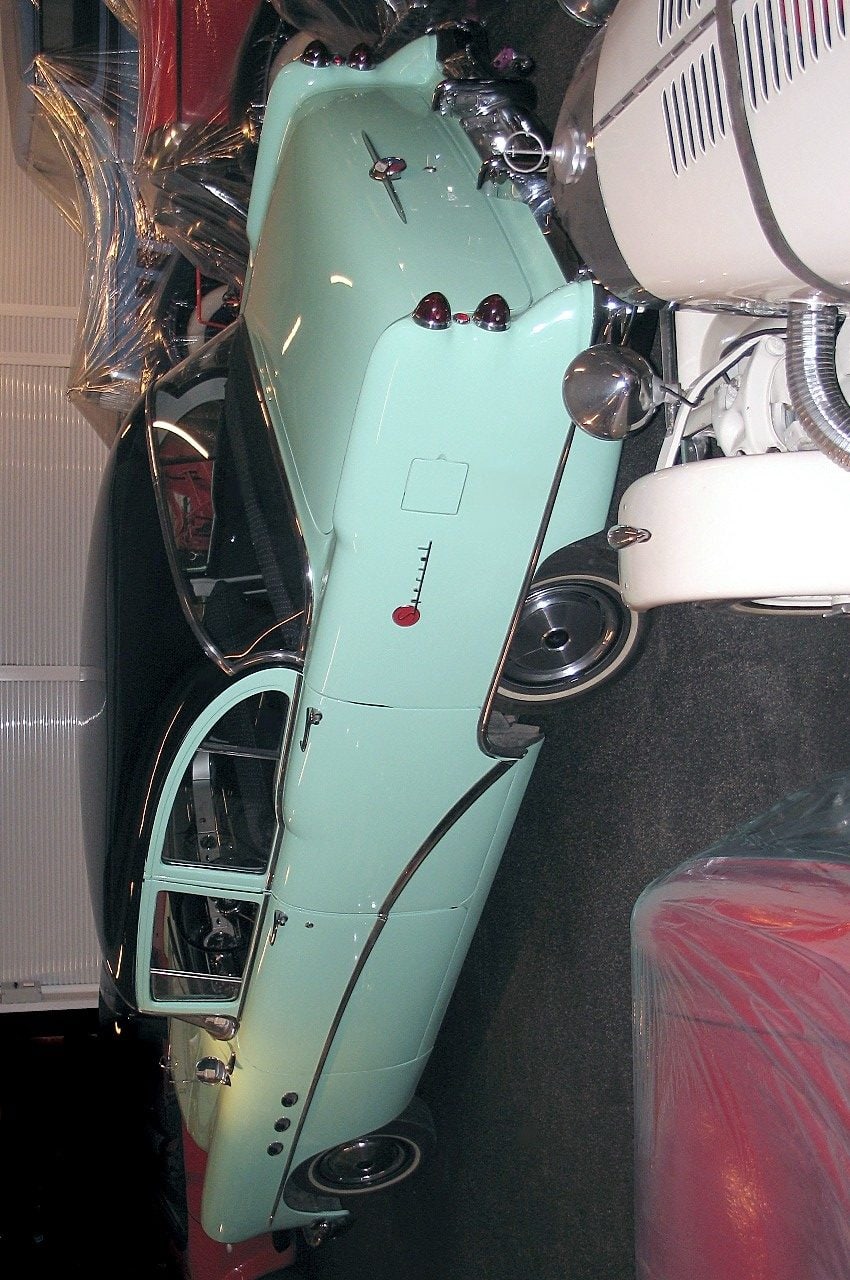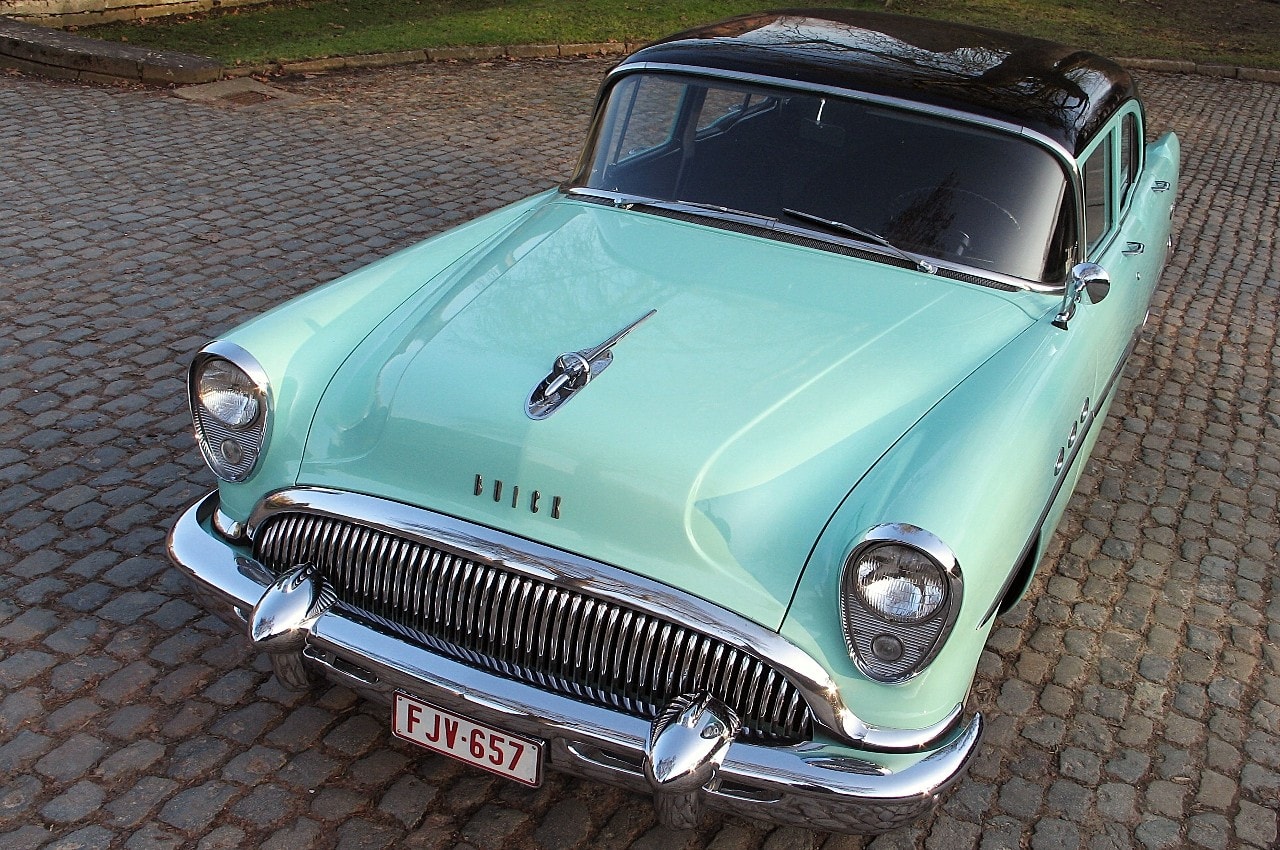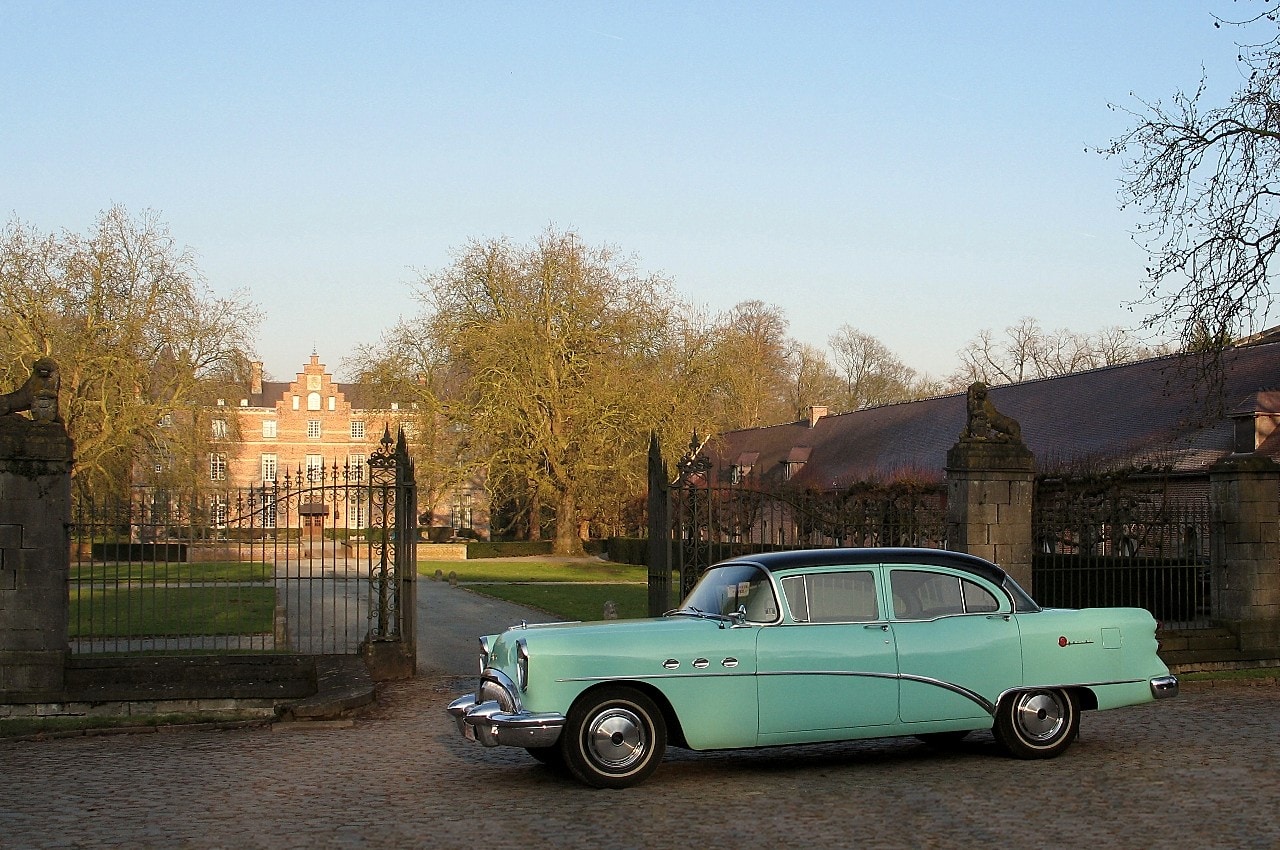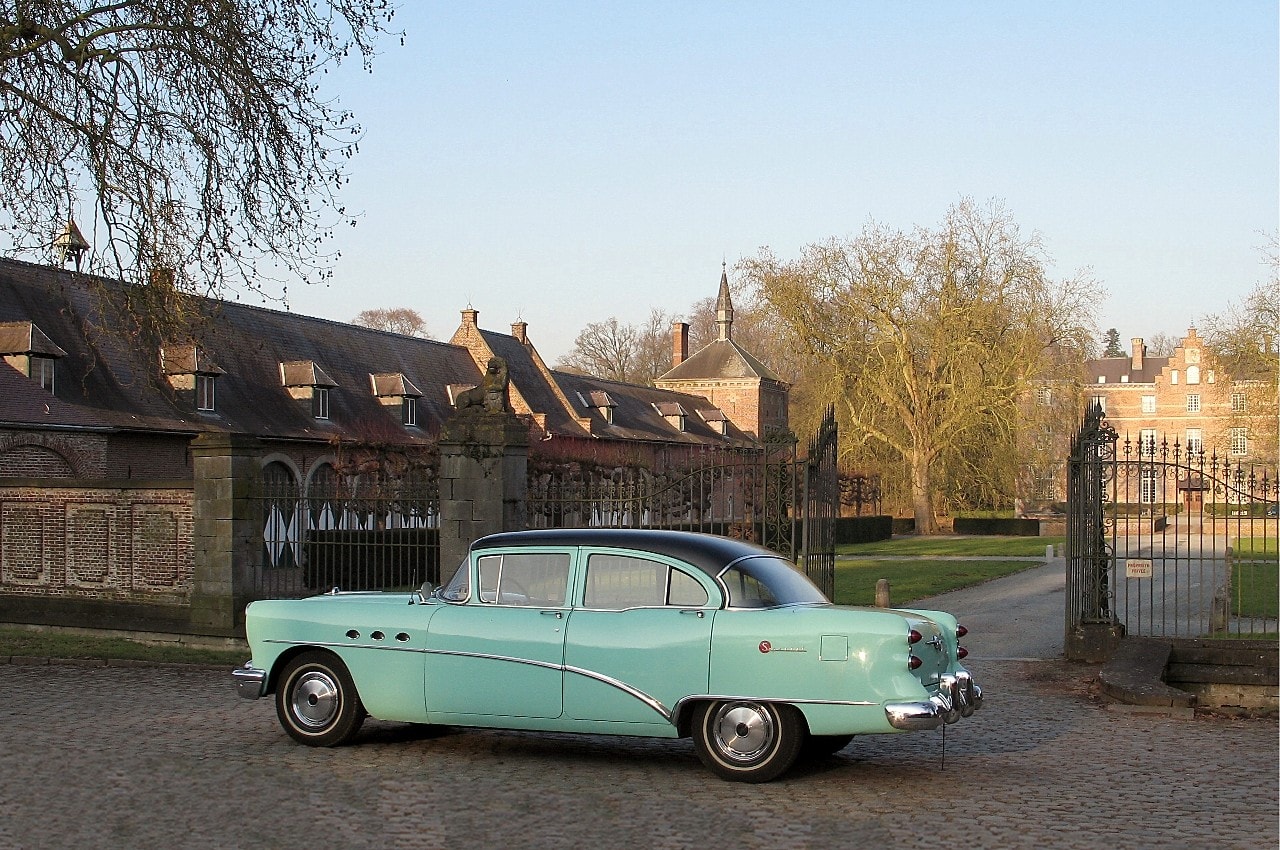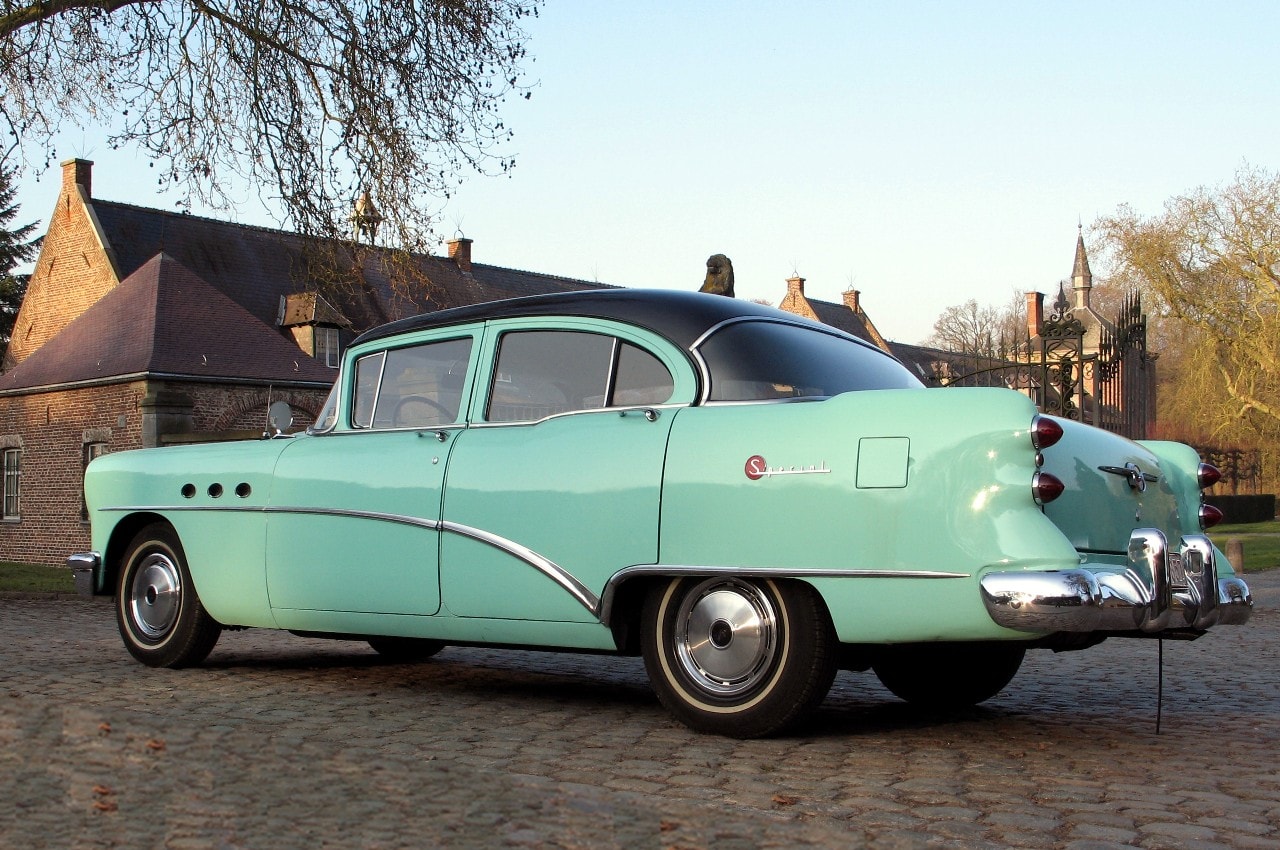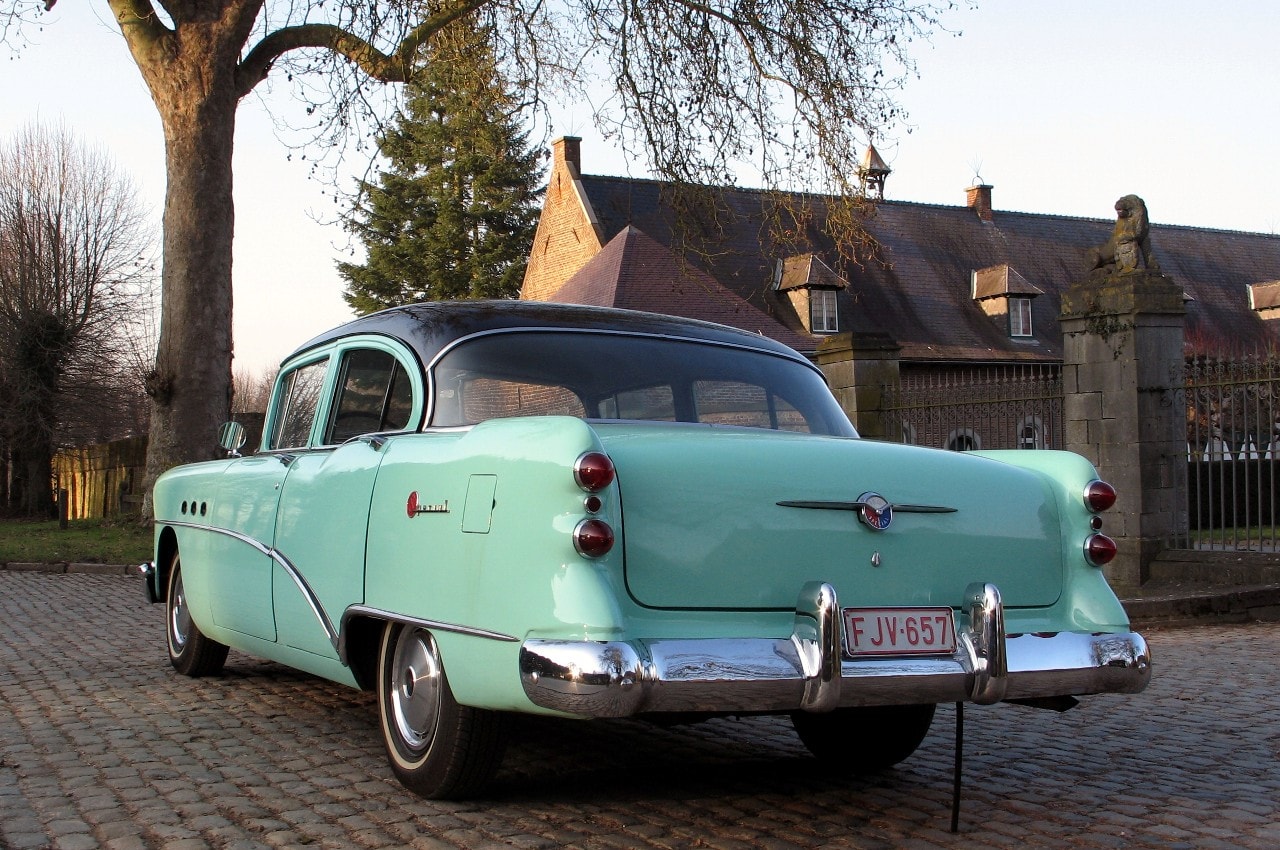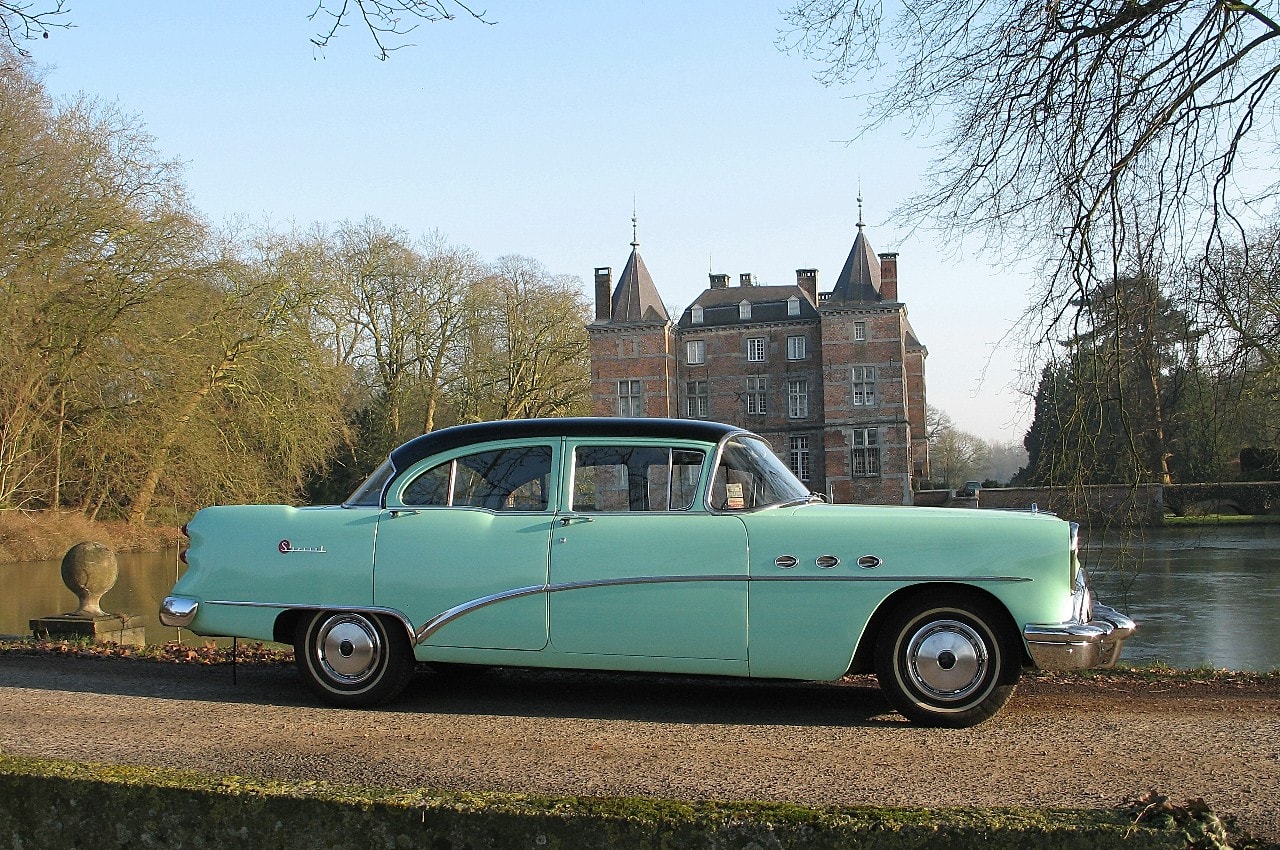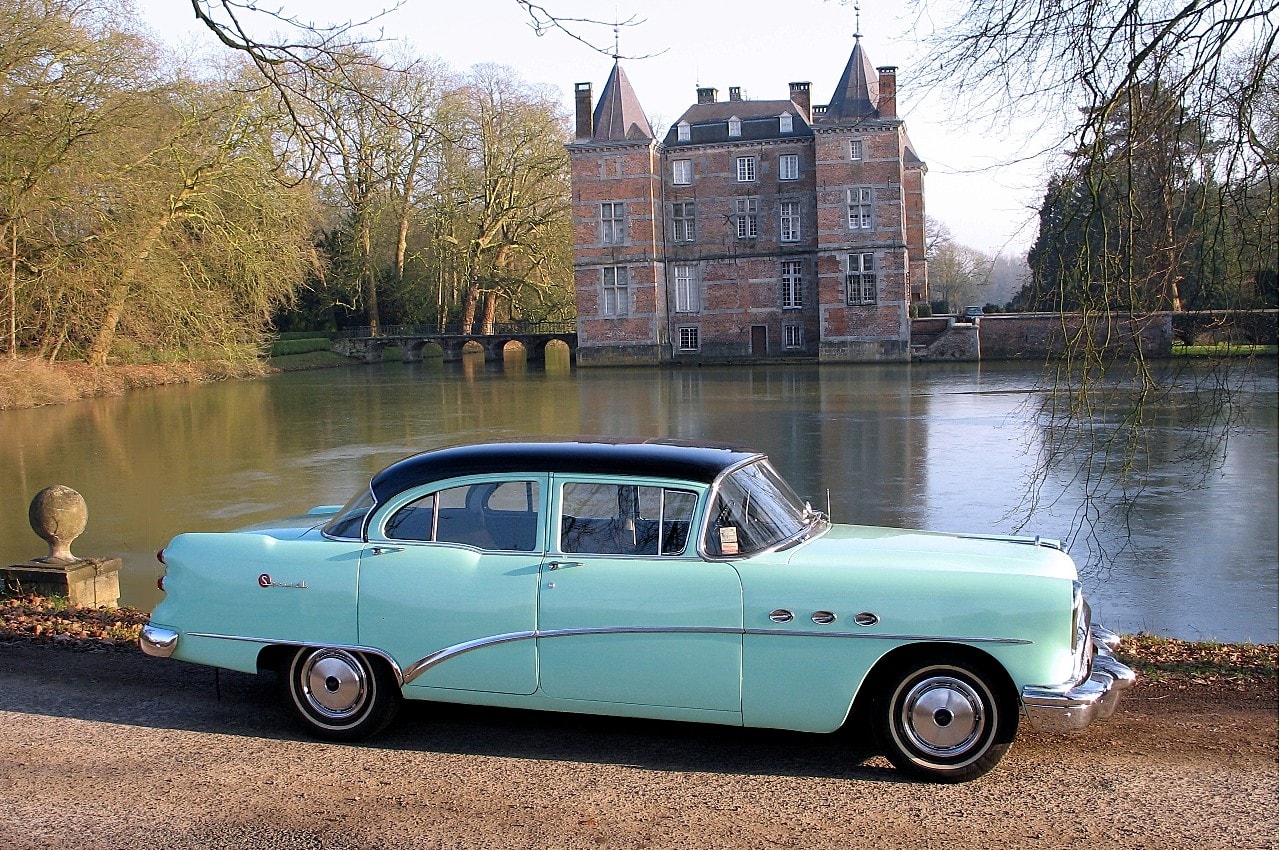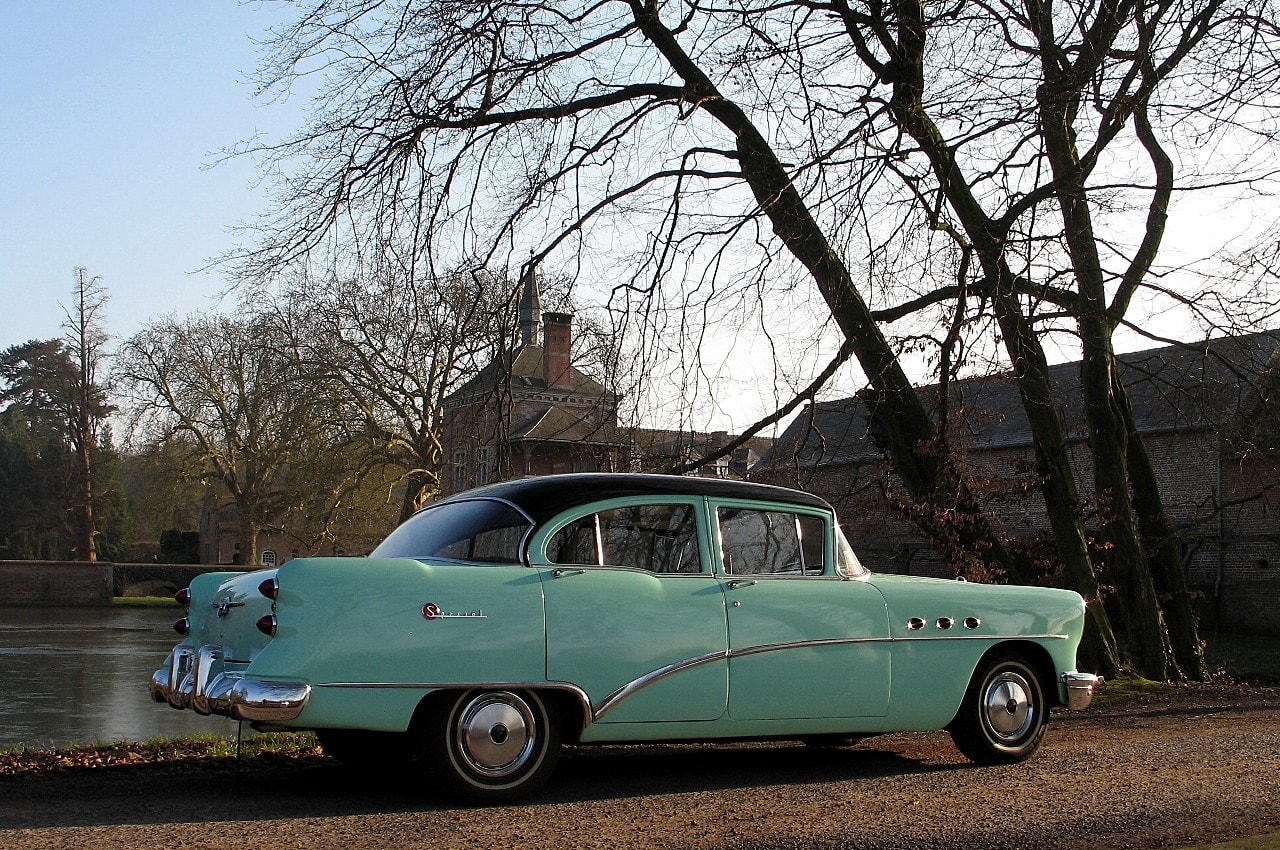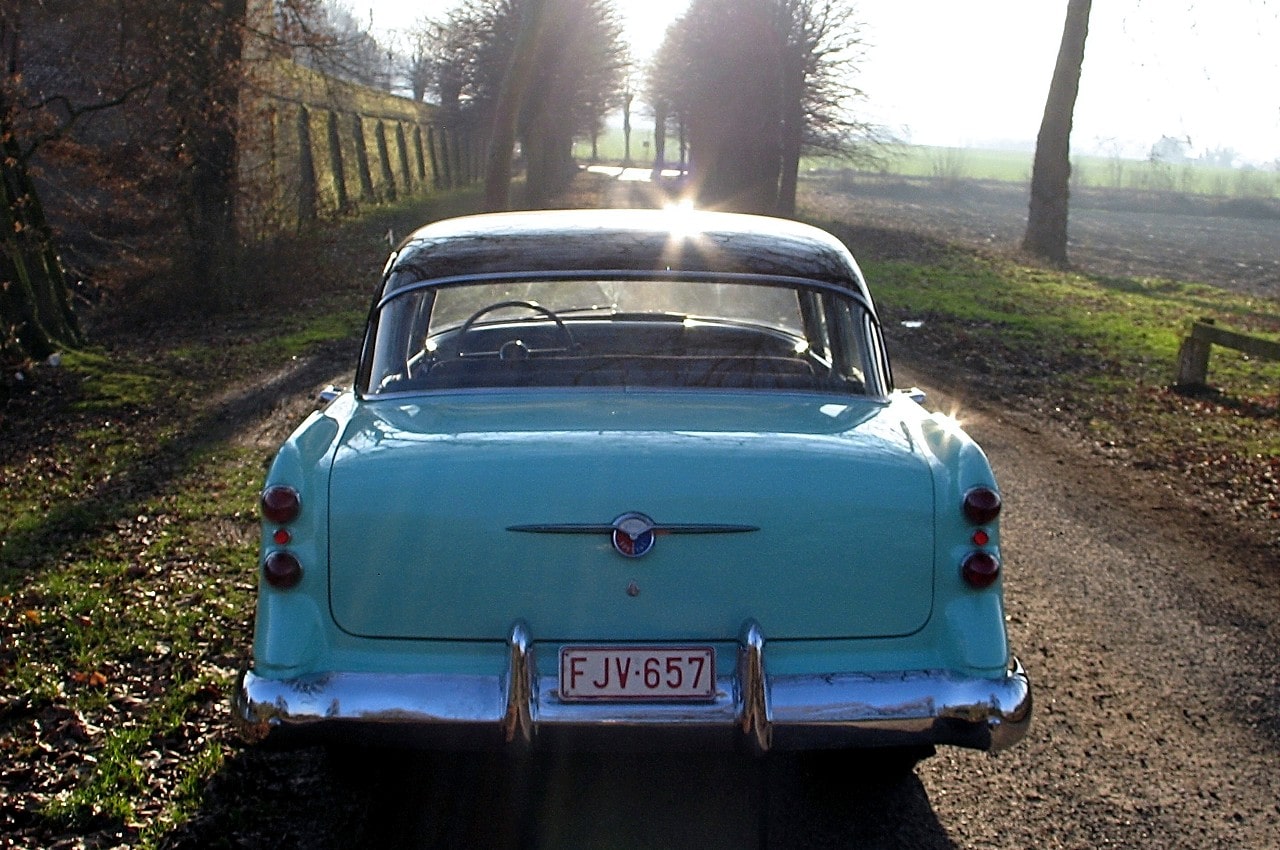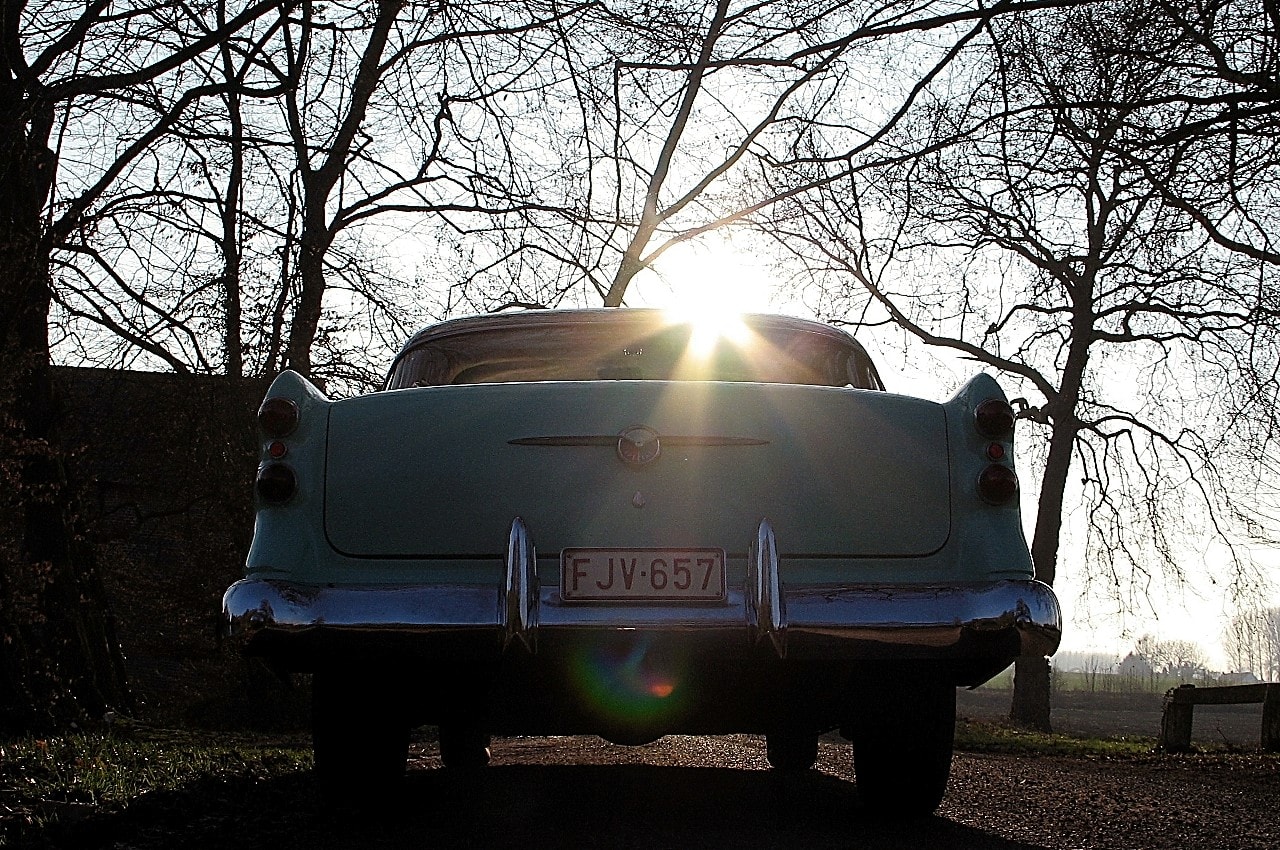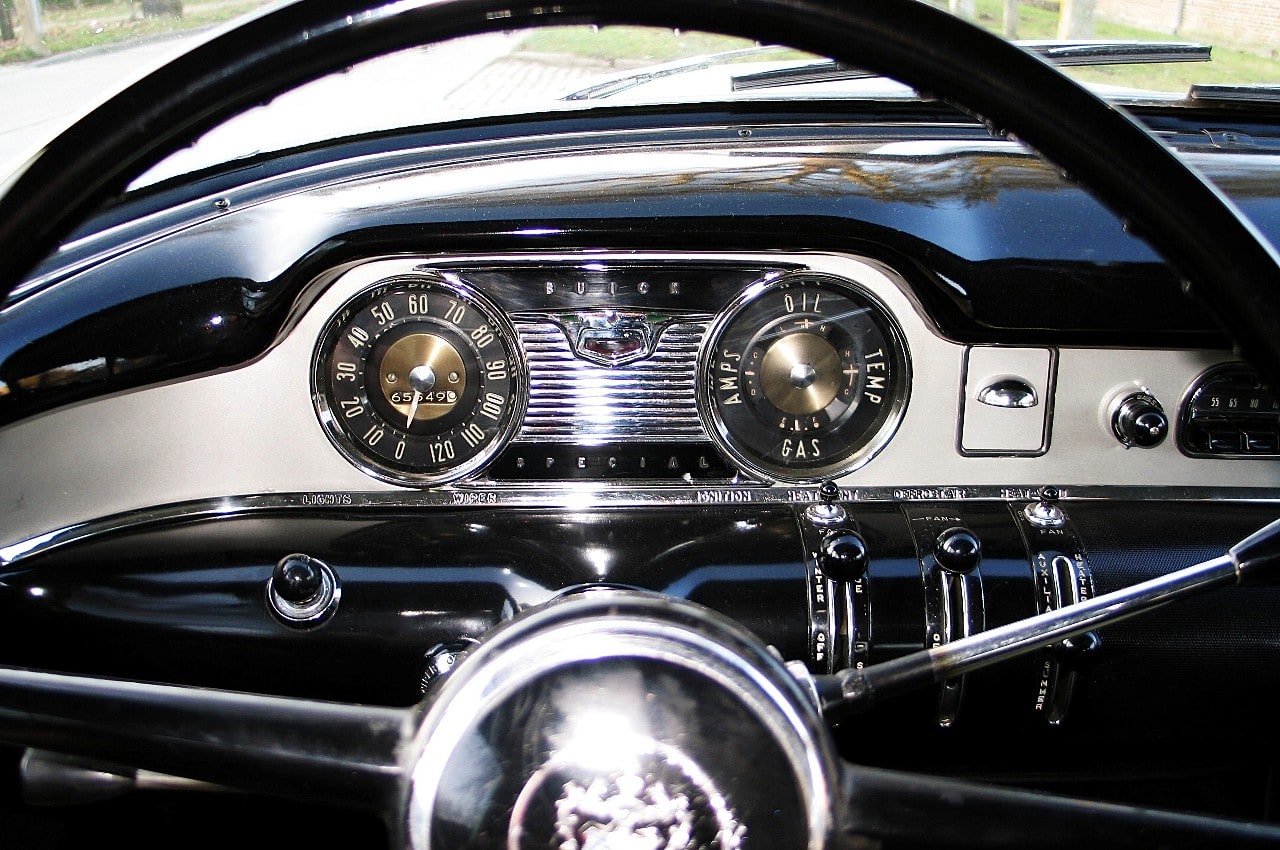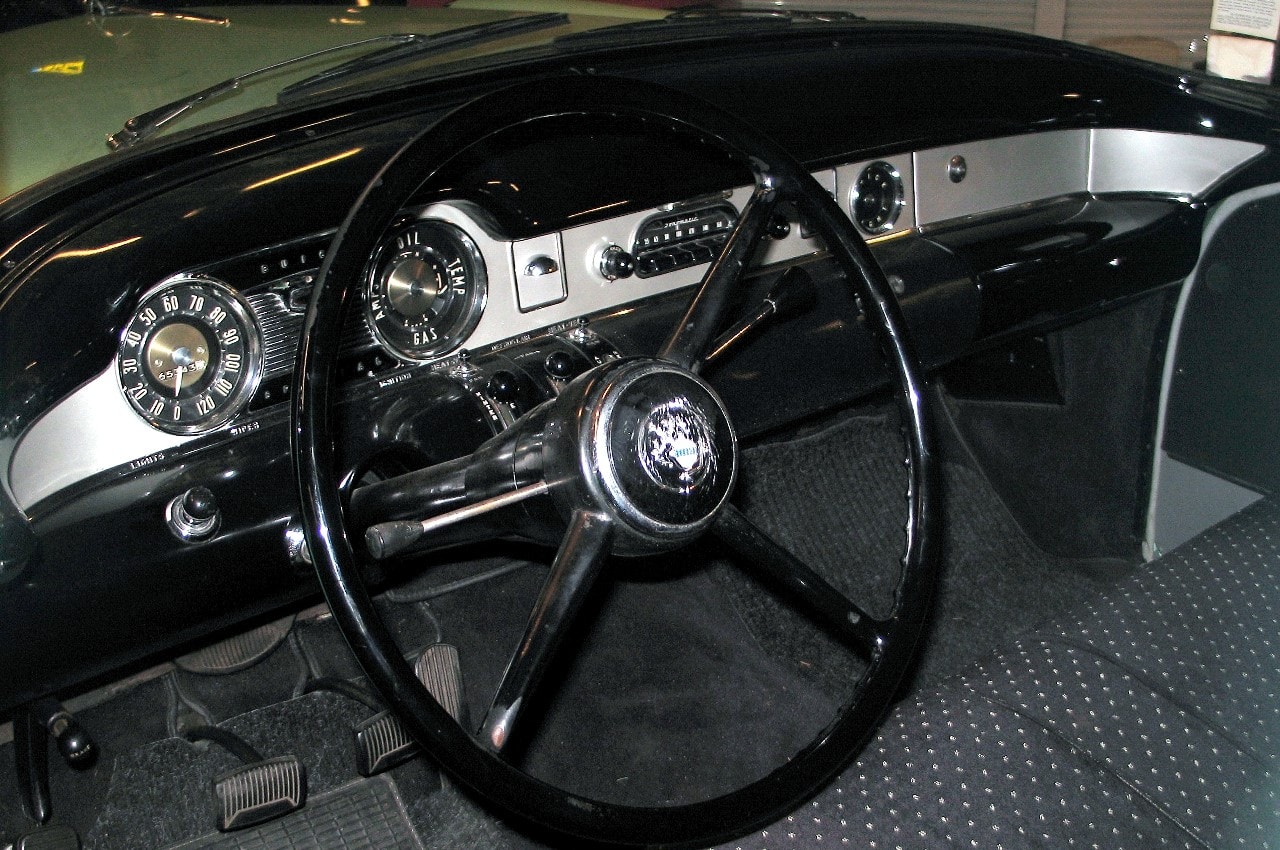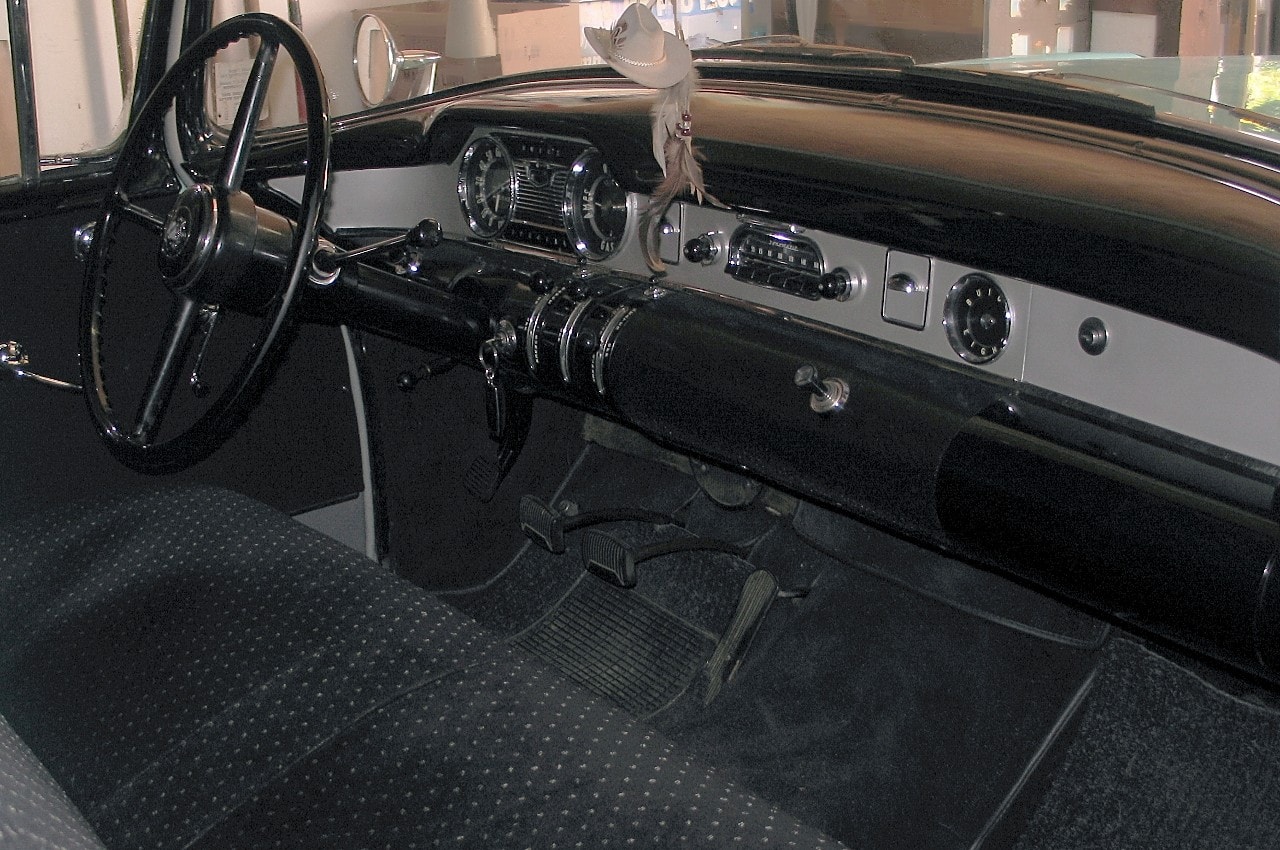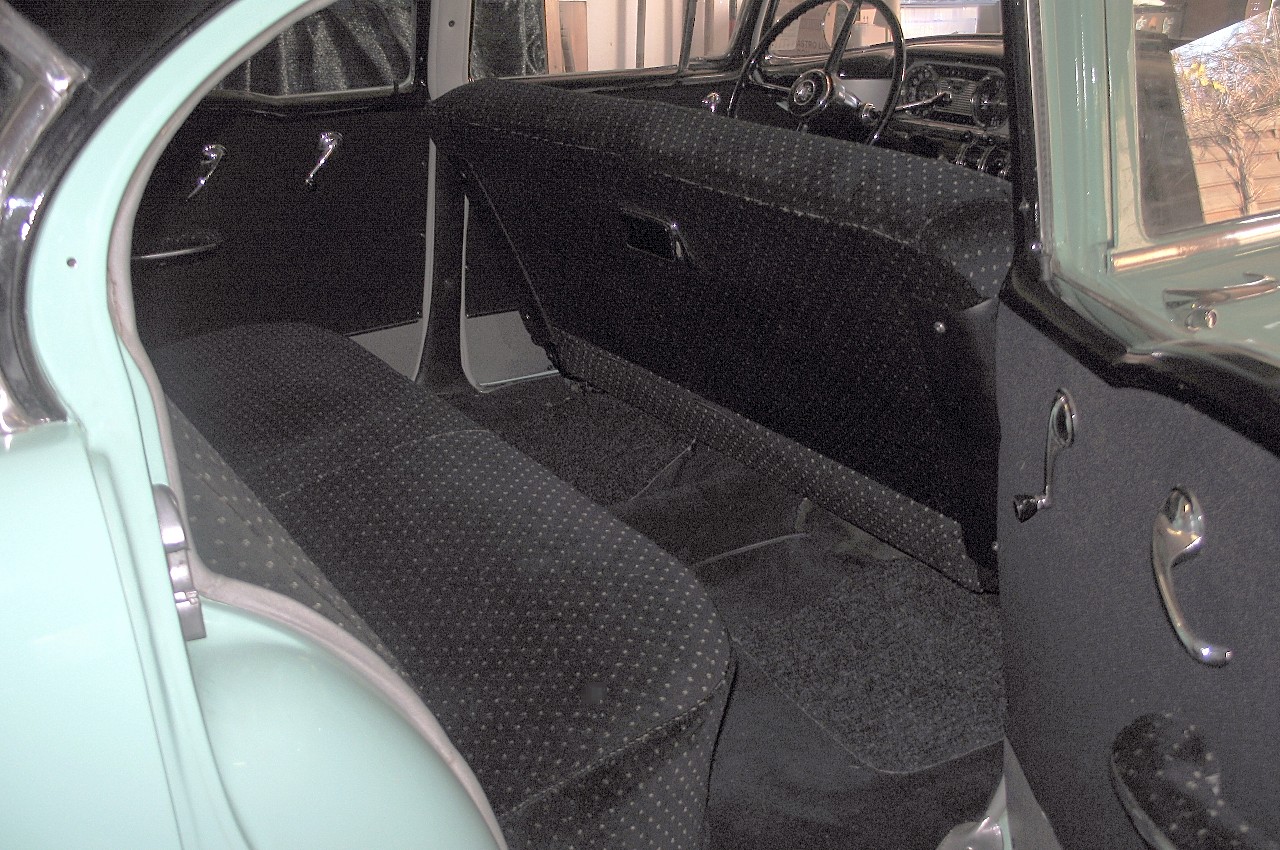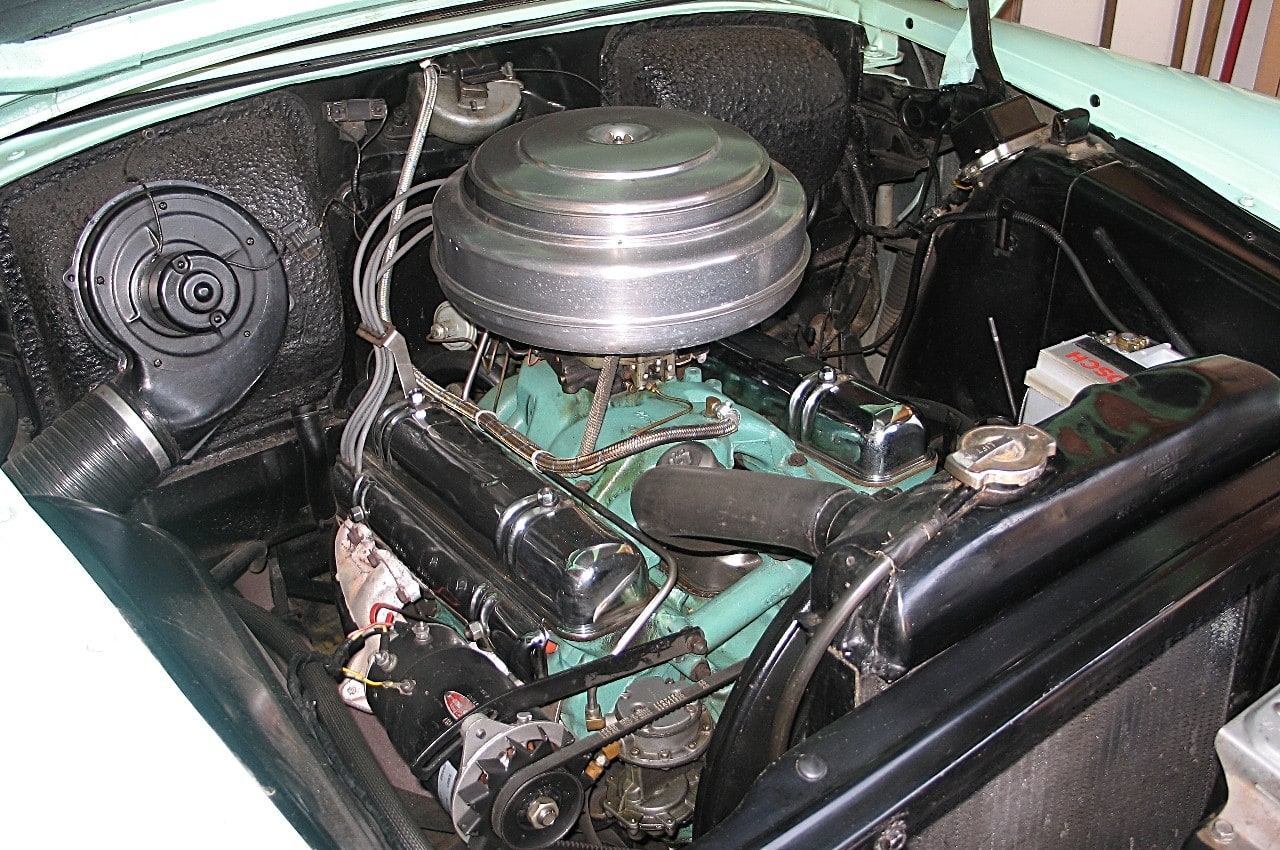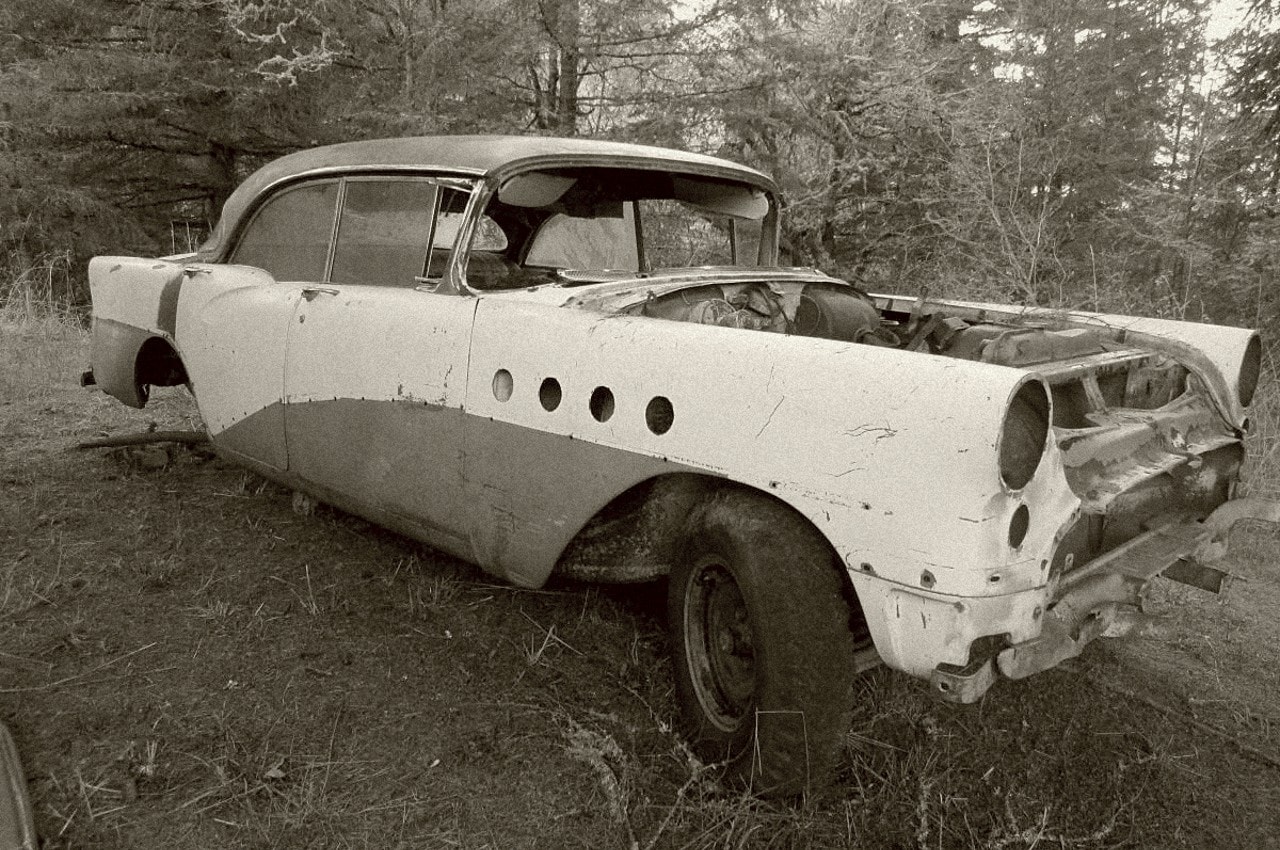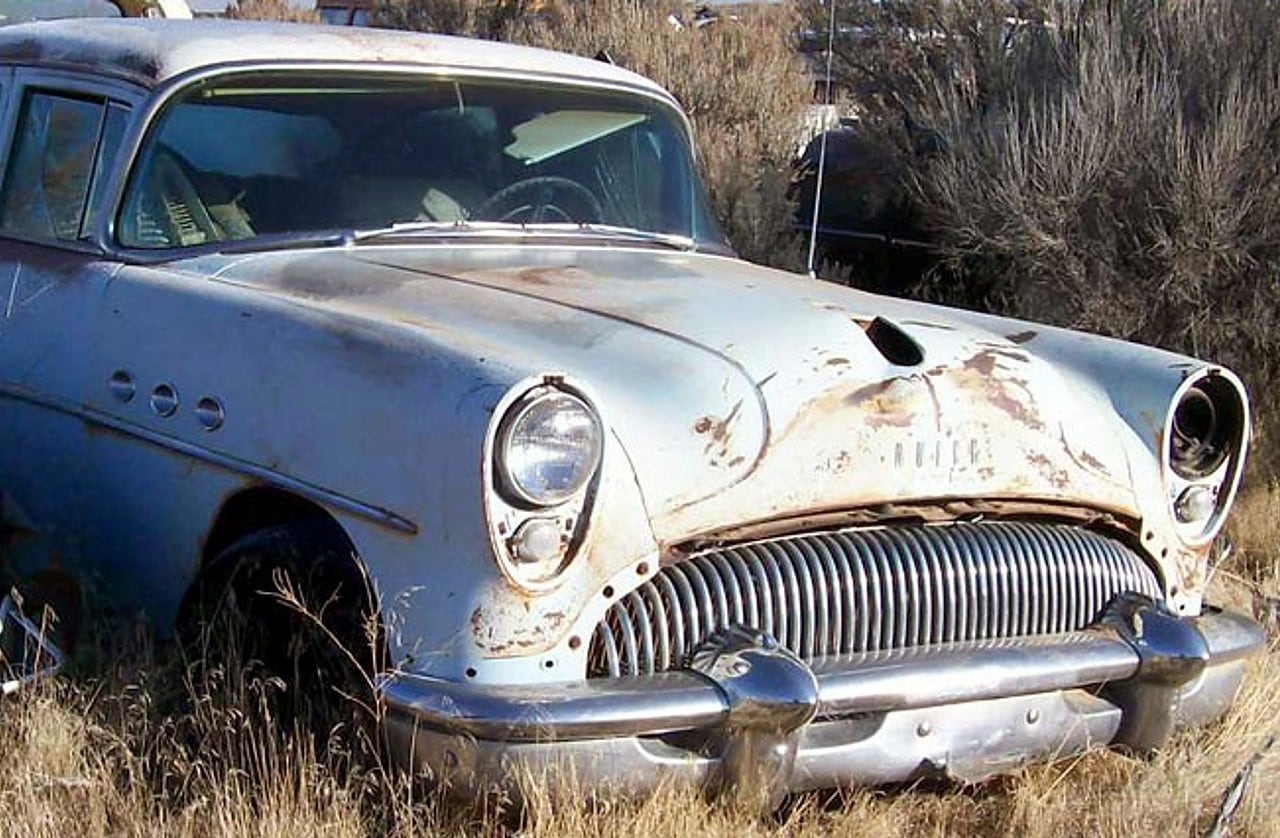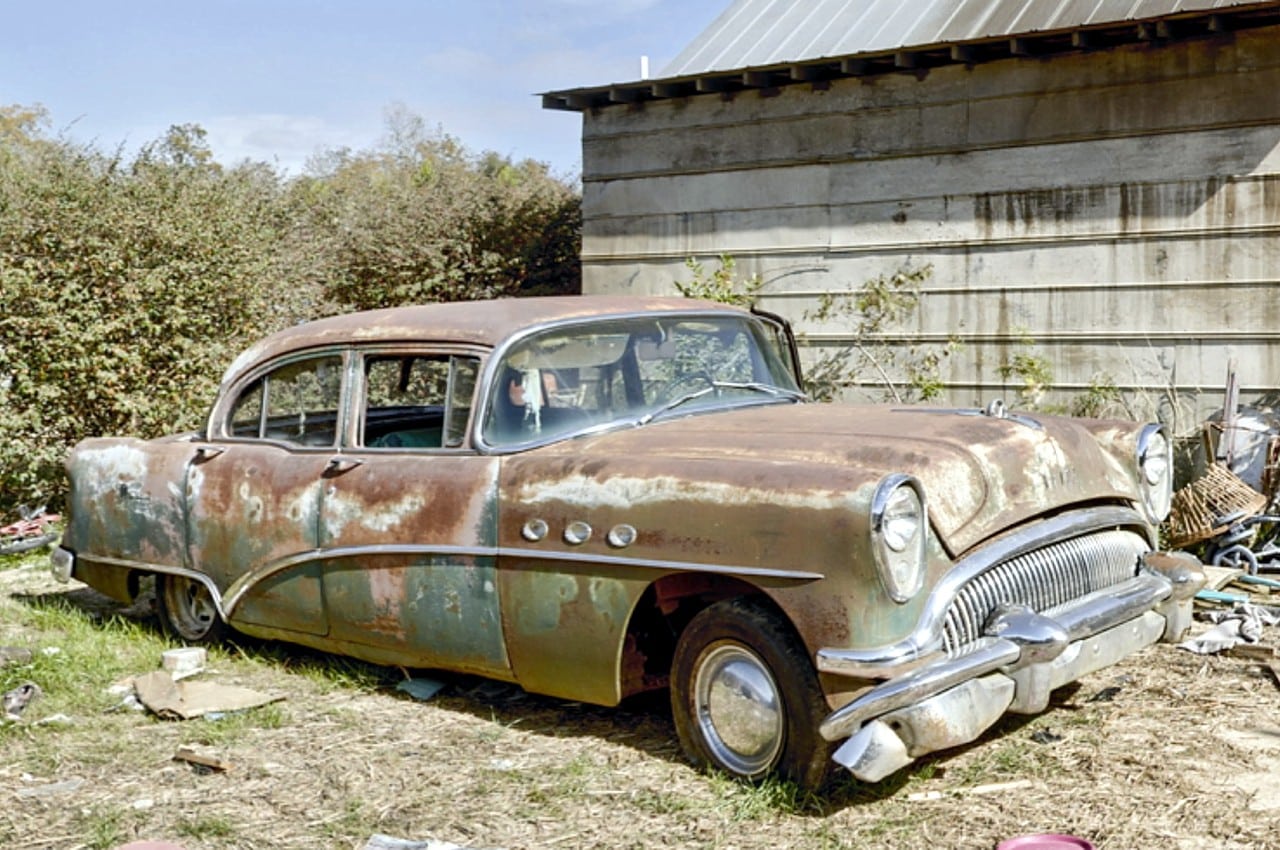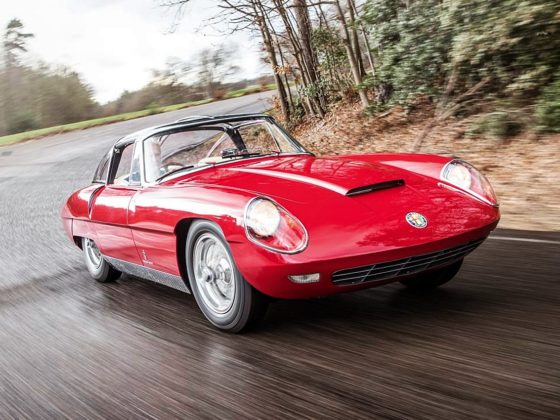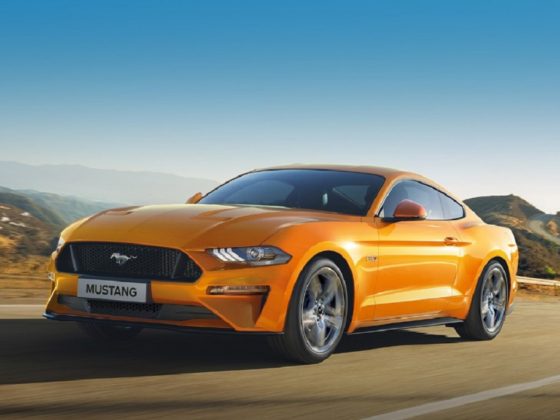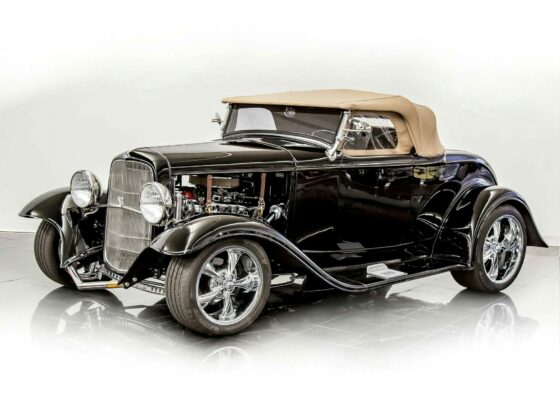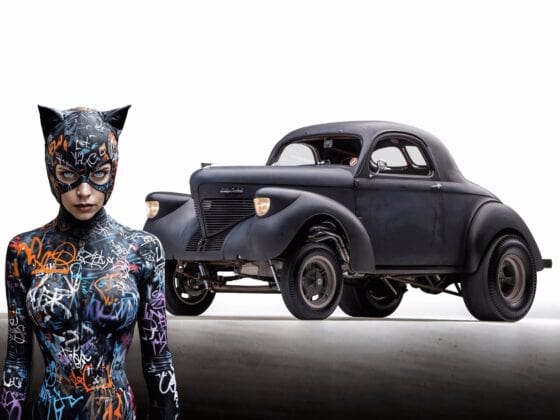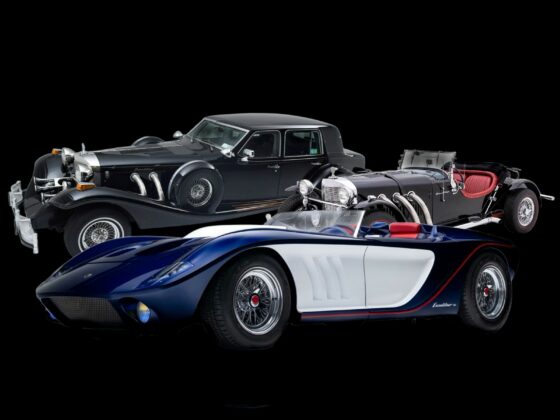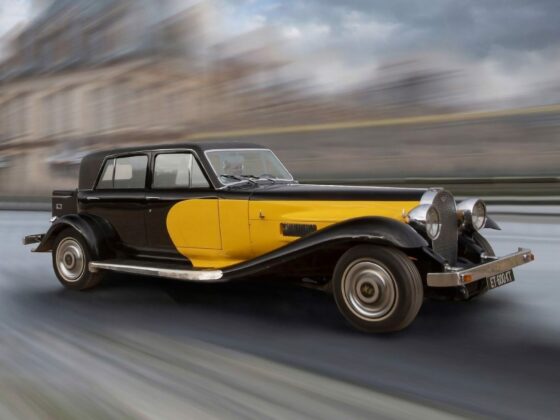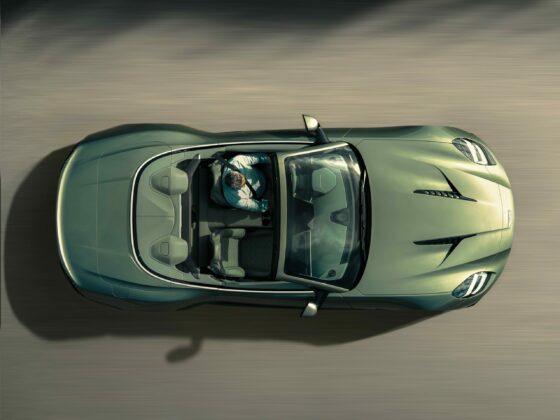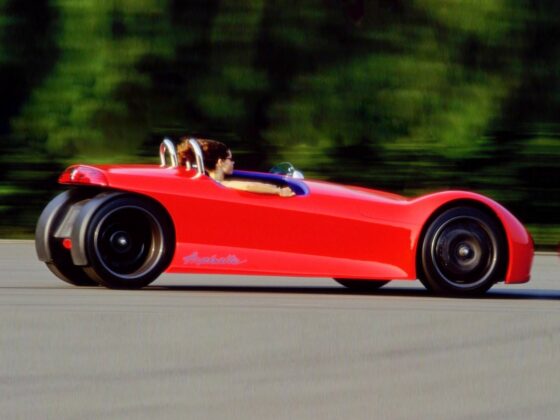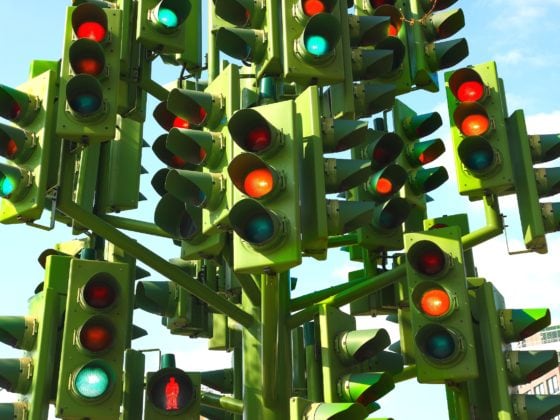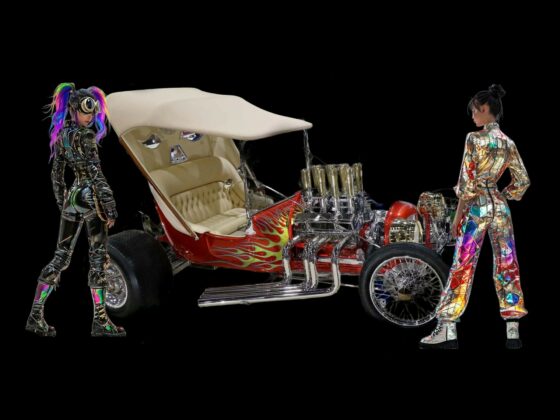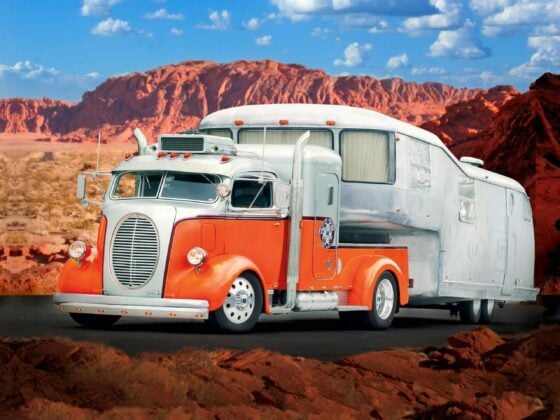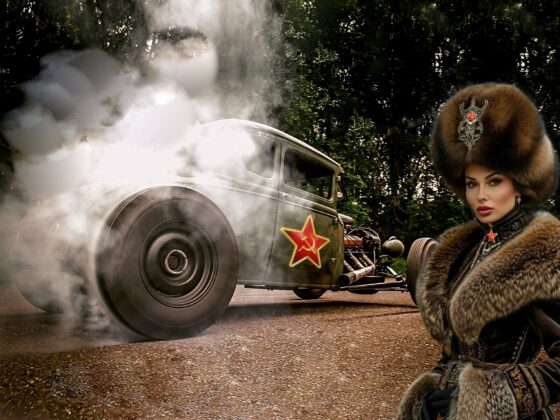1954 Buick Special…
Imaginez-vous quelques instants en Floride, vous vous appelez Bill, votre moitié se prénomme Daisy…, vous roulez relax sur l’Interstate… en Buick 1954.
Vous venez de Miami, l’océan Atlantique à votre droite, L’intercoastal à votre gauche, ou s’amusent quantités de gens en Hors-bord, la climatisation est à fond à cause de la canicule.
Votre voiture est tellement belle qu’on dirait qu’elle est tout droit sortie des usines Buick aux USA.
Vous arrivez à l’endroit qui vous a fait rêver toute l’année, un meeting aérien d’avions anciens mixé à une réunion de voitures des années ’40, ’50 et ’60…
– “Ahhhhhh! Daisy chérie, le vingtième siècle a toujours confondu la beauté des voitures et celle des femmes jusqu’à ce que tout fusionne dans les oeuvres d’art”.
– “Dans les oeuvres d’art ! Tu parles d’une oeuvre d’art” !… dit Daisy pendant que vous garez la Buick devant le B-25 Mitchell de son père, un collectionneur d’avions de légende, surtout ceux de la dernière guerre mondiale…
– “C’est l’été, on est en vacances et j’ai peur qu’on va de nouveau se faire c… avec des engins dans des réunions de fanatiques, au lieu d’aller se promener dans les forêts, le long des rivières dans les montagnes. Au lieu de vacances paradisiaques, on va errer à l’état brut dans un décor soigné de tôles sur fond de Rock’and’roll, pire que revivre comme des décors Hollywoodiens, je rêve que la nature nous tombe dessus d’un coup. Mais tu t’en f… de la nature, ce que tu veux c’est juste passer des vacances dans l’esprit des années cinquante… OK, je retourne chez ma mère”.
– “M’enfin, Daisy adorée, tu sais pourtant que”…
La moitié des hommes, fans de quelque chose (voitures anciennes, foot, etc.), préfèrent s’occuper de leur passion plutôt que de faire des galipettes avec leur chère et tendre, dixit un sondage mené par le S.i.r.c…(Social Issues Research Centre) auprès de deux mille personnes.
En conclure que l’automobile ancienne passe avant le sexe, serait cependant aller un peu vite en besogne, car le spectacle de l’ambiance de réunions de voitures anciennes en tant que tel (sic !) peut procurer une forme de jouissance…
Suite à un show, alors que je ne vais “normalement” plus dans les shows de bagnoles, j’ai rencontré un retraité désireux de vendre sa “perle rare”, une Buick Special de 1954, selon lui jamais restaurée, même pas “repeinturée”, la voiture ayant gardé sa couleur originale Willow Green (sic !)…
– “J’ai acheté ça d’un gars de pas loin de chez moi qui l’avait depuis toujours, achetée neuve, un passionné d’automobile comme moi”… qu’il m’a raconté.., ajoutant : “Ce gars, je le connaissais depuis un bon bout de temps déjà, on partageait un intérêt commun pour l’automobile… et on n’avait pas mis beaucoup de temps à bien s’entendre. Et quand est venu le temps pour lui de vendre la Buick qui traînait dans son garage, j’ai eu le premier droit de regard… et je n’ai pas raté ma chance. Il n’y avait absolument rien à faire dessus, j’étais bien heureux de mon achat. J’ai fait trois expositions avec la Buick et gagné des trophées qui décorent mon salon. J’ai même réussi à dénicher toute la documentation sur cette voiture depuis sa sortie de l’usine !”…
– “Ah oui, c’est cool, vraiment bien, tout à fait Rock and Roll”…
– “L’appellation «Special» est apparue pour une première fois chez Buick en 1936, le modèle représentait l’entrée de gamme des voitures “pleine grandeur” chez cette division luxueuse de General Motors. Après une refonte esthétique franchement réussie en 1949, la Special allait rester similaire jusqu’en 1958, puis disparaître du catalogue de vente de Buick pendant deux ans, revenant sous une toute nouvelle forme en 1961…, et finalement, elle est disparue pour de bon en 1969″…
– “Vous pourriez m’en dire plus ?”…
– “Ce modèle est un millésime 1954, équipé d’un V8 de 264ci qu’on avait baptisé Nailhead : “Tête de clou”, si on veut traduire…, ce moteur avait été introduit en gamme pour sa première année dans la Special en 54 qui accueillait aussi un tout nouveau châssis ainsi qu’un look revampé…, bref, une grosse année pour Buick ! Des Buick Special, vous n’en verrez jamais beaucoup, même si vous faites le tour des expositions de voitures anciennes dans toute l’Europe, chaque semaine de chaque mois de chaque année durant plusieurs décennies…, il vous faudrait aller aux USA ou au Canada… et encore, c’est pas certain”…
– “Et quoi d’autre pouvez-vous me dire ?”…
– “La Buick Spécial 54 se déclinait en plusieurs versions ; coupé, berline, convertible et familiale (break-station-wagon)… et la berline 4 portes familiale est la plus commune…, faut n’avoir rien d’autre dans la dent creuse pour l’acheter, faut être un pneu Rock’and’Roll aussi… Avec ses quatre portes ce modèle est impressionnant…, en comparaison avec les voitures d’aujourd’hui, la Buick est tout simplement énorme… et pour les “connaisseurs”, sa couleur Willow Green la rend très désirable”…
Je ne cherchais pas ce véhicule en particulier avant d’en faire l’acquisition, j’ai seulement été au mauvais endroit au mauvais moment… et j’avais le temps d’y passer 4 heures de discussions sans jamais proposer plus que 12.500 euros maxi pour cette “ricaine”…, venant de 35.000 ce fut un exploit, d’autant que je n’en avait nul besoin et que je n’aime pas les berlines 4 portes… mais en finale elle fut à moi, avec toute la documentation “ad-hoc”…, parce qu’elle faisait partie d’un “LOT” avec une Corvette Targa ’78 de 10.000 euros…, la paire pour 22.500 euros !
J’ai direct allumé la radio, une fois au volant de la Buick… et je suis parti en Cruisin, sans savoir si j’allais rester vivant !
Vous en avez un aperçu avec la vidéo…
Rapidement, je me suis quasi déboîté le genou déjà mis-à-mal par un problème de cartilages… tellement l’embrayage était athlétique-tique-tique… et que le poids (la pression) a apporter à la pédale d’accélérateur était digne de “Rambo”… ce qui, ajouté à une direction sans assistance, a direct rendu ma balade Rock’and’roll pire que me trouver dans un concert de Rock-Métaleux, coincé entre deux enceintes…, c’était cauchemardesque…
Le fait de manœuvrer deux heures au volant pour la parquer ajouta un caractère d’extrême urgence à ma décision de revendre vite-fait-bien-fait, cette monstruosité… et je suis retourné chez le vendeur…
– “Etant donné les circonstances, je ne peux garder cette auto”…, que j’ai sangloté.
Le bonhomme s’est torché un bout de larme…
– “Humainement, je vous comprends. Mais les affaires sont les affaires, j’ai des frais. Mais bon, ça va, je suis pas un ogre. Voyons un peu la marchandise”…
Il se met à tourniquer autour de la charrette, à ausculter dedans comme s’il l’aurait vue pour la première fois…
– “Quelle horreur, elle est turquoise ! Vous savez que ce n’est jamais demandé, une couleur pareille. Ça se faisait y a cinquante ans… Et puis dites, vous entendez le moteur, comment qu’il bat la breloque. Il a de l’asthme ou de l’emphysème ! Je parie qu’on a foutu de la sciure dans le pont pour pas qu’il chante ! Et les boudins, dites ! On voit plus le dessin ! Combien qu’il marque le compteur ? Faut pas me la faire, vous avez remis l’horloge à l’heure ! Si vous feriez à pinces la différence entre ce qu’elle marque et ce qu’elle a déjà parcouru, vous vous useriez les flûtes jusqu’aux genoux ! Une 54 ? Mais non, une 53 puisque juin fait partie du Salon précédent ! Sans compter les gnons qu’elle a dû prendre ! Tenez, cette aile est repeinte. Voyons, qu’est-ce que je peux vous offrir de ce tas de tôle ?… Disons 5.000 euros puisque vous êtes dans le malheur !”…
– “Mais, je vous l’ai payée 12.500 euros !”…
– “Et alors, j’y peux quelque chose ?”…
J’avais eu le courage et l’opportunité de réaliser une centaine de photos peu après cet achat intempestif… que j’ai envoyé par mail à quelques garagistes franchouilles… et c’est un garage du nord de Paris que j’avais pris pour cible, qui m’a proposé un deal “fumant”…, j’ai réussi à lui vendre sous la limite psychologique des 20.000 euros, (19.500)soit 7.000 euros de gagné desquels je devais défalquer les coûts (gigantesque) d’essence et autres frais de roulage… et lui m’a rendu la pareille (un deal de cons !) assorti dans un échange sur une Corvette 66…
Je ne sais ce qu’elle est devenue…, la Corvette par contre s’est avérée typique de ce jeu de dupe, c’était une merde aussi… que j’ai finalement échangée dans un autre deal absurde avec un garagiste Hollandais…
Yeahhhhhhhhhhh, c’était vachement Rock’and’Roll…
Ci-après de quoi faire le bonheur de ceux qui causent anglais…
Roadside America is flashing past your eyes as the wind whips through your hair ; your chin sitting on your folded arms on top of the rear windowsill as you stare out the open window.
The images of neon-lit diners, catchy-named motels, and split-window coupes become lost in the back of your mind as your youthful thoughts drift into the realm of the future.
But something far off to the east catches your wondering eyes; a flash from the setting sun bouncing off the nose of the car traveling at you in the other lane.
Lifting your head off your arms, and leaning out the window for a better glance, it becomes apparent that the mirror-like finish is the chrome on a new Buick, reflecting anything that it sees.
It flashes past you like Buck Rogers on his way to another mission, and you quietly slip back to your own little world.
All that chrome so many years before had been just a small part of the redesigned Buick.
Touted as “The Beautiful Buy,” those three simple words in 1954 helped launch the Flint-based marque into third place in the industry with 9.65 percent of the total market.
Only one year removed from their 50th anniversary, Buick’s redesign had actually started to take shape four years prior, and several design cues were hinted at with the 1952 sightings of the Buick XP-300 concept car.
Much of it came into fruition thanks in part to the Skylark in 1953, which would appear again in 1954, though in much smaller numbers.
Buick made more noise with the reintroduction of the Century.
Built on the Special chassis, engineers dumped the larger Roadmaster V-8 under the hood, creating “one of the three fastest American stock cars” according to Floyd Clymer, capable of cruising easily at 100 mph.
Four-barrel carburetors were no longer found exclusively on the Roadmaster.
Yet through it all, Buick’s biggest seller was once again the Special.
As had been a Buick standard for several years, four VentiPort-clad fenders indicated that the model that wore them was a Roadmaster, with three VentiPorts per fender reserved for the Special, Super and Century.
However, unlike previous years, the Special did not stand alone regarding body dimensions.
The small series, 122-inch wheelbase platform shared its body and trim with the new Century, while Super and Roadmaster sits on the larger 127-inch wheelbase platform.
Finally removed from the Buick horsepower lineup was the increasingly outdated 263-cu.in. straight-eight, and in its place was a new 264-cu.in. V-8, capable of either a 143hp or a 150hp rating depending on transmissions.
A refined front suspension – which could be found under the entire Buick line – helped support the new V-8.
Exterior designs, at first glance, look to be similar to the 1953 model year in some aspects, however that quickly erodes when you start with the grille.
Slimmer “teeth”, and more of them, grace the continued waterfall design, while new bumper guards take on the bullet design.
Turn signals still reside under the headlamps, surrounded by decorative teardrop chrome trim similar to that found on the XP-300, while a new, slim sweepspear design takes a ‘V’ dip, then continues aft rather than returning forward as in previous years.
This new sweepspear had been found on the 1953 Skylark.
The rear fender design is vastly different than 1953, with a noticeable ridge residing on top at the aft end.
Model emblems are chrome with the lead letter surrounded by a circular sea of red.
The Special line outsold its sister Buicks with a total run of 190,884 units – not including stripped chassis – 72,254 more than the second place Super.
There were five available variations offered to the buying public, the most popular of which is our featured car, the Special Riviera Hardtop with 71,186 units ; second on Buick’s 1954 best seller list behind 73,531 Super Riviera Hardtops.
The Special Hardtop carried a base price of $2,305, certainly not the cheapest Buick.
That honor went to the Special DeLuxe two-door Touring Sedan starting at $2,207.
The Special DeLuxe four-door Touring Sedan started at $2,265, the Special Estate Wagon – produced entirely out of steel for the first time – at $3,905, and the Convertible round off the Special offerings at $2,563.
Aside from an increase of Estate Wagon production to just over 3,000 units, the Riviera hardtop was pushed hard by Buick, which set an industry record of 500,000 hardtops produced since their initial mid-year release in 1949.
Another Buick landmark record was set on May 3, 1954 with the production of their two-millionth Dynaflow transmission.
ENGINES
A new V-8 offering awaited buyers after Buick’s decision to nix the smaller straight-eight that had been used in 1953.
In fact, there were two variations of the new 264-cu.in. powerplant, depending on which transmission had been designated to mate with it.
The base offering – with the standard three-speed transmission – produced 143hp at 4,200 rpm from the 264, compliments of the 3.625 x 3.20-inch bore and stroke.
A two-barrel Stromberg AAVB-267 carburetor fed fuel and air into the cylinders, only to find a compression ratio of 7.2:1.
Hydraulic lifters were once again a Buick standard, and the torque rating stood at 228-lbs.ft. at 2,400 rpm.
The other 264 offering carries the same 3.625 x 3.20-inch bore and stroke, hydraulic lifters, and Stromberg carburetor.
The difference comes in that, when mated to Buick’s Dynaflow automatic transmission, the compression ratio jumps to 8.0:1, in turn increasing horsepower output to 150, and torque to 240-lbs.ft.
As with Specials of previous years, its sizable production translates into the greater possibility of finding unmolested engines in either form.
The Buick engine remains virtually indestructible, if the previous owners had maintained it properly over the years.
Even better, there are several companies that have been offering complete engine rebuild kits.
TRANSMISSIONS
Since its 1948 introduction, the percentage of Buicks produced with the Dynaflow transmission grew exponentially each passing year.
By the time the 1954 model year rolled around, 85 percent of the Buicks produced were equipped with the automatic transmission; traditionally found as standard equipment on the Roadmaster, and available as an option in the Super, Century, and the Special.
The second generation, twin-turbine Dynaflow had been introduced in time for the 1953 model year.
Complicated enough to explain in detail as its own subject, the designated name given is simply due to the fact that it contains two turbines.
As with the initial multi-year Dynaflow offering, rebuild kits are easily accessible, and there are rebuild specialists within the Buick collector community, if you’re not comfortable tackling the job yourself.
Usually bulletproof if not overheated – hoses carry radiator coolant to the transmission, then back to the radiator, and with a heater and defroster there is about 30 feet of hose installed – simple maintenance avoids long-term problems, and early reports of excessive fluid leaks had been resolved long before the arrival of the 1954 models.
With the proliferation of the Dynaflow, the chances of finding any Buick with a manual transmission are somewhat slim.
That’s not to say that Buick didn’t offer a manual transmission.
Truth be told, the Special, Century and Super all were offered with a Syncromesh three-speed manual transmissions as standard, as had been the case for several years, and Buick would continue to offer the three-speed as standard equipment in the Special through its model name cancellation after 1958.
Our featured Special happens to house the three-speed, which is a column-shift unit freeing floor space to allow six-passenger seating.
Any kinks in the armor had been eradicated with exception of wear on the clutch plate.
Only second and third gears are synchronized, meaning that it may require adjustments, realignment, or worst case, replacing over time.
Once again, with such a wide window of production, replacement parts can be obtained, or the unit can be sent out for rebuilding.
REAR AXLE
Once again, not unlike the engine compression ratio, the choice of transmission dictated the rear axle ratio.
Power arrives at the rear axle thanks to Buick’s continued use of the torque tube, ending its forward-to-aft journey at a 3.6:1 final drive ratio, if it had passed through the Dynaflow transmission.
Though in the case of our featured Special equipped with the three-speed, the ratio is 3.9:1.
Several pre-1954 models came equipped from the Buick assembly line with a 4.1:1 ratio, however recent owners installed the 3.9:1 ratio for better drivability in today’s fast-paced highway system.
SUSPENSION
Buick’s ‘Million Dollar Ride’ was given a slight upgrade for the 1954 editions ; for the most part, entirely up front.
Attached directly to the frame are the new direct-acting shock absorbers.
Being independent of the springs, replacing the shocks eliminates having to realign the front end.
“Finger-tip steering”, according to one critic, was yet another step closer to a true reality for Buick with an upgraded steering linkage and geometry that contributed to better steering control, less strain on components and more stability while cornering.
Suspension parts are readily available, and even the continued use of the knee-action shocks in the rear suspension can be rebuilt if they have not been excessively abused over the decades.
BRAKES
Disc brakes ?
A long way off when it comes to Buick.
Four-wheel hydraulic drums were the status quo in 1954, and power assist was an option at that, meaning you better have a decent breakfast before trying to stop nearly 4,000 pounds of rolling metal, if it’s not installed.
Finding a Special with power brakes might not be as daunting a task as one might think and, no matter which hydraulic system is in place, the news is even better.
Buick, for several years, used the same wheel cylinders, meaning there seems to be an endless supply of units available.
Rebuild kits are rather numerous as well.
Master cylinders, though not nearly as numerous, can still be found with a little effort, or a core exchange will enable you to install a freshly rebuilt unit.
New shoes are not a problem, either.
Keep in mind that the front shoes have a 2.50-inch wide lining, while the rears measure 1.50 inches wide, so be sure you keep track of which set you’re installing at which end.
BODY/FRAME
Buick continued to use the beefy X-frame to support their new body, which is lower to the ground than in previous years.
The hood is also lower, and the trunk lid is a touch higher for a sportier look.
The windshield took on a new configuration with the A pillar standing vertically on the four-door DeLuxe sedan, or a reverse angle on the rest of the Special line ; effectively resulting in a wrap-around windshield.
Perhaps more striking is the new sweepspear as described earlier.
Several pieces combine to make the V pattern from front to rear, however a slight difference in rear fender design may go unnoticed at first glance.
The Riviera hardtops and convertibles all had a circular rear wheel opening, while the four-door models and the two-door sedan all had a squared-off rear wheel opening.
This results in three different trim assembly numbers.
Unfortunately for two-door DeLuxe Touring Sedan owners, it is a model by itself, sharing the sweepspear trim with no other 1954 Buick model.
Not so for the others, beginning with the other two four-door models.
The Special Estate Wagon (Model 49) and DeLuxe Touring Sedan (41D) share its trim with the equivalent Century Estate Wagon (69) and the Touring Sedan (61).
Two door models have more options available, thanks to the ’54 Skylark having been produced on the smaller Century wheelbase.
The Century two-door Riviera Hardtop (66R), Convertible (66C) and Skylark (100) trim will interchange with the Special Riviera Hardtop (46R) or Convertible (46C).
The same can be said for related body panels, with the exception of the Skylark, which lacks cutouts for the VentiPorts.
Other minute details, such as the upper grille bar, will fit any 1954 model, however the outer grille bar extensions from a Roadmaster or Super will not fit the Special, Century or Skylark.
While the frame is usually found in solid condition, it’s the lower body panels and rocker panels that can take a beating, especially in the traditional snow-belt regions.
Floor and rocker panels are reproduced for many models, however body panels are not, and NOS panels are scarce.
INTERIOR
The Specials arrived with a nylon cloth interior, however a two-tone cloth and Cordaveen – Buick’s name for vinyl – combination was available, except on two models.
Our featured Special came standard with a two-tone interior, and the convertible arrived with leather trim.
A slightly wider body means that there is a touch more interior space to be had for you and five good friends.
A new dash welcomed buyers, in some models radically different from previous years.
As had been the case in prior years, the 1954 Super and Roadmaster does not share its new ‘Red Line’ speedometer dash with the Special or Century.
Instead, two circular gauges are set into a stainless housing, with the left gauge being the speedometer and the right gauge containing the other necessary instruments such as oil and water temperatures, gas gauge and amps.
Between the two is the Buick shield separating the turn signal indicators, with the marque name above, and the model name below.
The radio is once again centered in the dash, with radio controls and dash-mounted ashtrays on either side.
One further step to the right of the radio and you’ll find the optional electric clock and the glove box at the far end.
Below the right-side ashtray is the lighter.
Under the left ash tray and the right instrument cluster are the airplane-inspired controls for the vents and fan, with the optional air conditioning controls mounted below.
Ignition and wiper controls straddle the steering column, and the light switch has been relocated to the left side of the dash just under the speedometer.
If an optional electric antenna was installed, the toggle switch was also mounted at the bottom of the dash of the left side.
One source lists the dash center panel as being painted in a cream color, while the rest matches the exterior body color, however restorations can provide much different results.
RESTORATION PARTS
Most mechanical items for many Buicks are being reproduced.
But when it comes to most trim items and body panels, a little searching will be required.
NOS items are harder to locate each passing day, so finding a reputable chrome shop may be a necessity.
Be sure to pay close attention to your part numbers with the variation in Buick body sizes.
Your best bet, as with any collector car, is to locate a master chassis and body parts book, making part number decoding much easier.
They also help avoid the dreaded “it doesn’t fit right” phrase during a restoration or repair…
Only 65.000 km, Only 2 owners from new, Concours condition ! Valued : € 25,000.00
It is sometimes said that the old American as the Buick 1954, heavy and clumsy, that they are iron to iron…
